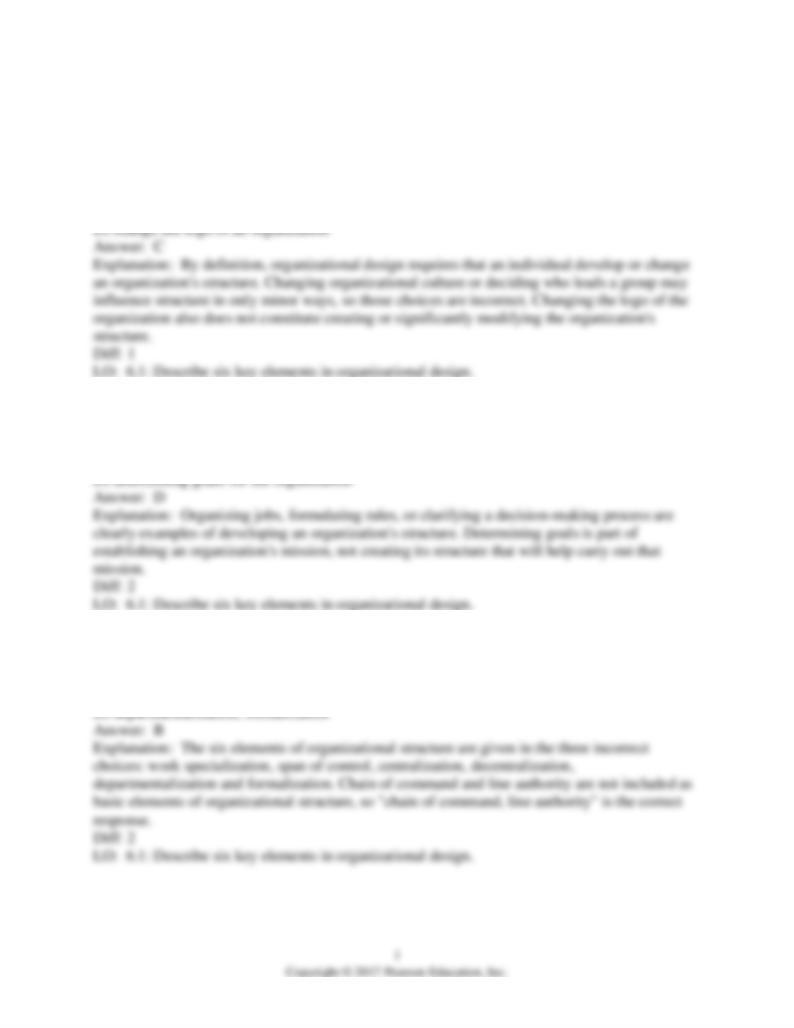
Fundamentals of Management, 10e (Robbins)
Chapter 6 Organizational Structure and Design
1) Organizational design requires a manager to ________.
A) decide who leads a group within an organization
B) change the culture of an organization
C) change or develop the structure of an organization
2) All of the following are part of the process of organizational design EXCEPT ________.
A) deciding how specialized jobs should be
B) determining rules for employee behavior
C) determining the level at which decisions are made
3) Which of the following are NOT basic elements of organizational design?
A) work specialization, span of control
B) chain of command, line authority
C) centralization, decentralization
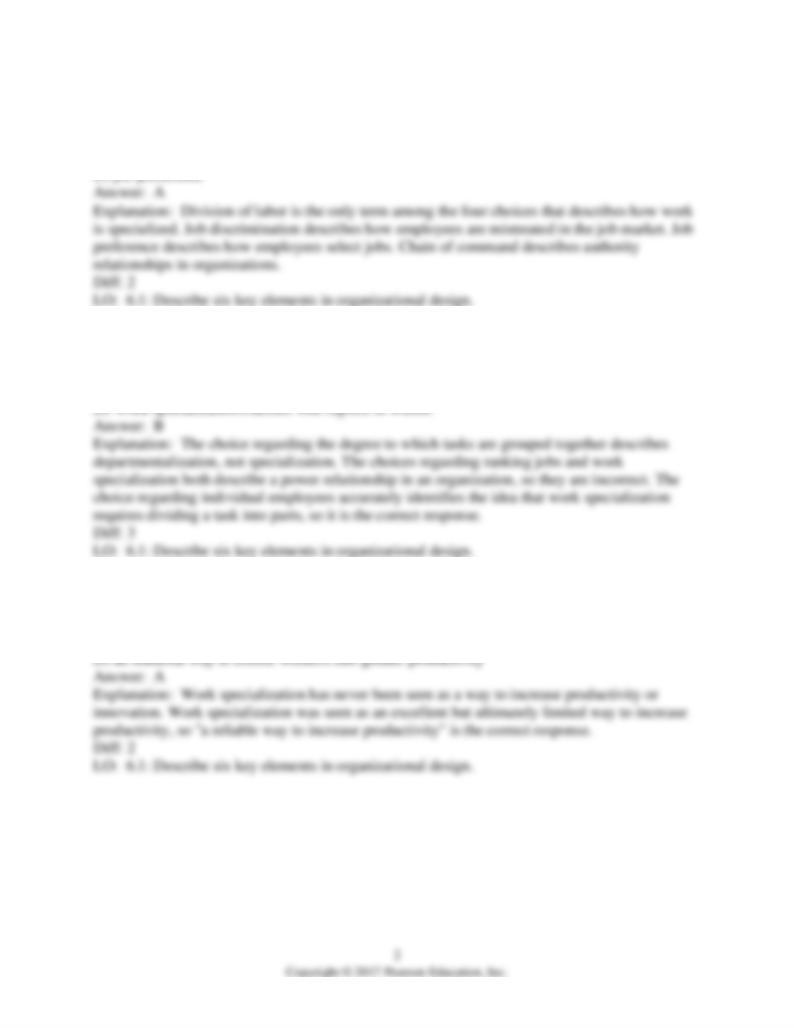
4) Which of the following is synonymous with work specialization?
A) division of labor
B) job discrimination
C) chain of command
5) Which statement accurately defines work specialization?
A) It is the degree to which tasks are grouped together.
B) Individual employees specialize in doing part of an activity rather than the entire activity.
C) Jobs are ranked relative only to their worth or value to the businesses.
6) Early supporters of work specialization saw it as ________.
A) a reliable way to increase productivity
B) a good way to increase employee morale
C) a source of innovation
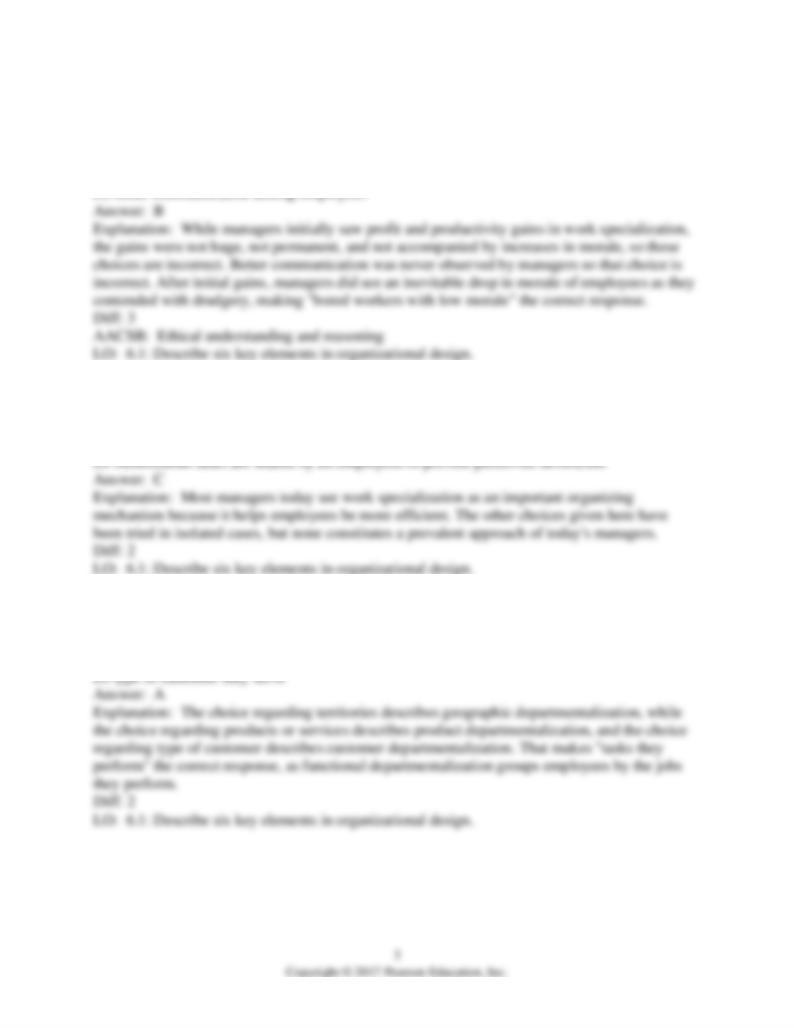
7) Early users of work specialization in the early twentieth century found that the practice
ultimately resulted in ________.
A) higher profits and better employee morale
B) bored workers with low morale
C) huge and permanent productivity gains
8) Today, managers favor this approach with regard to work specialization.
A) All tasks are performed by all employees to promote fairness.
B) Partners switch jobs every half hour to overcome boredom.
C) Employees specialize to maintain efficiency.
9) Functional departmentalization groups jobs by ________.
A) tasks they perform
B) territories they serve
C) products or services they manufacture or produce
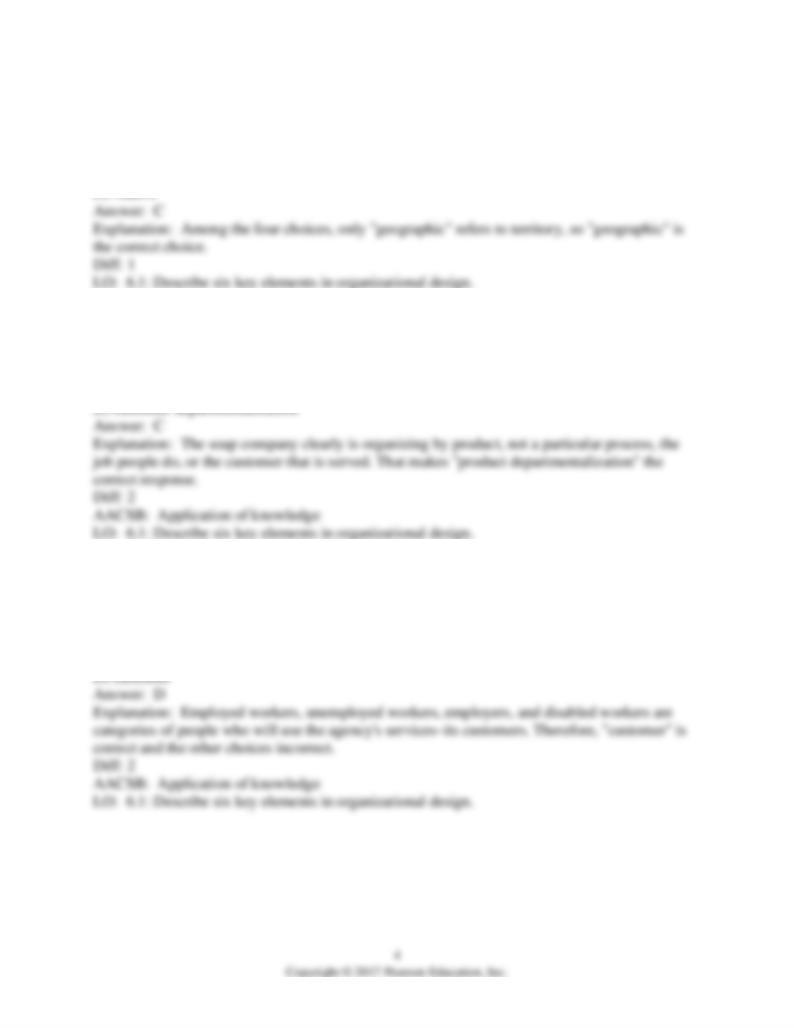
10) ________ departmentalization is based on territory or the physical location of employees or
customers.
A) Functional
B) Product
C) Geographic
11) A soap company that features a bath soap department, a laundry detergent department, and a
dish soap department is using which of the following?
A) process departmentalization
B) functional departmentalization
C) product departmentalization
12) What kind of departmentalization would be in place in a government agency in which there
are separate departments that provide services for employers, employed workers, unemployed
workers, and the disabled?
A) product
B) geographic
C) outcome
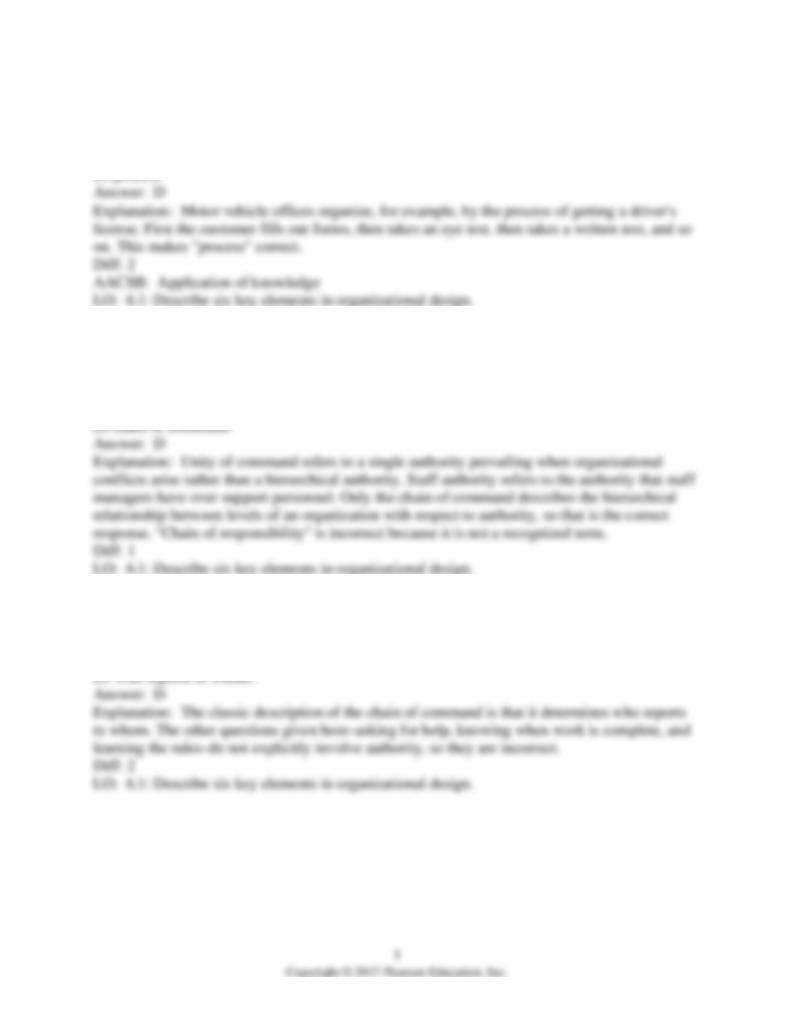
13) State motor vehicle offices usually use this kind of departmentalization.
A) product
B) functional
C) customer
14) The line of authority that extends from the upper levels of management to the lowest levels
of the organization is termed the ________.
A) chain of responsibility
B) unity of command
C) staff authority
15) The chain of command answers this question.
A) Where do I go for help?
B) How do I know when the task is complete?
C) What are the rules?
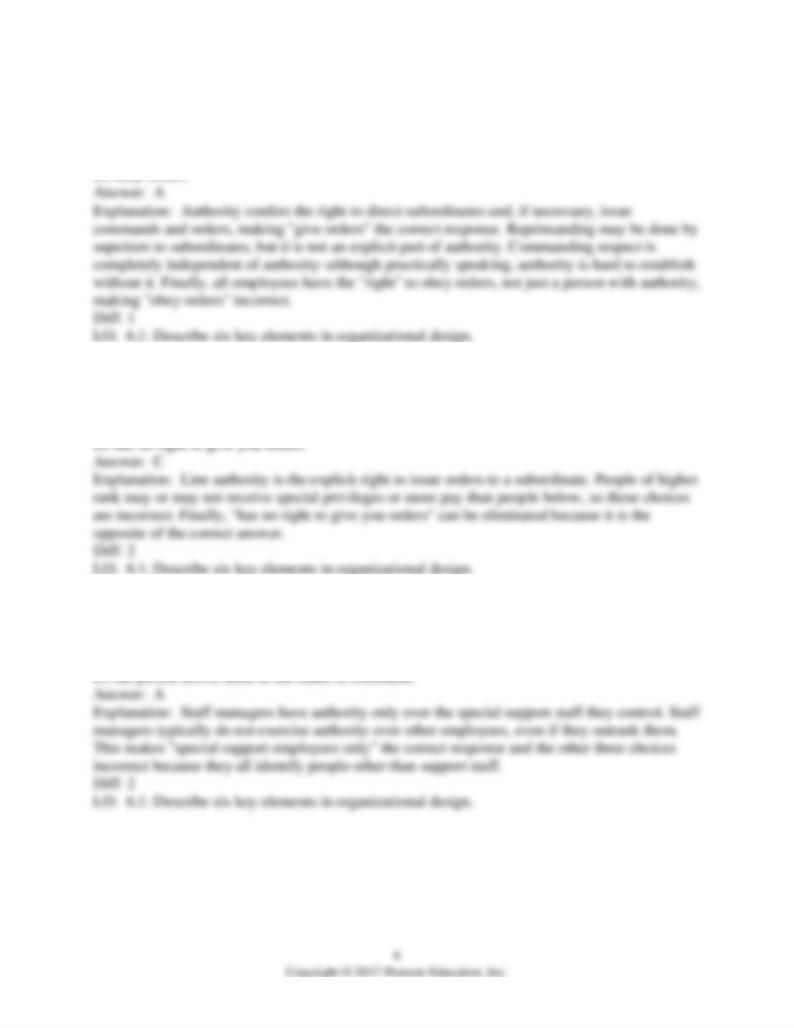
16) Authority gives an individual the right to do this.
A) give orders
B) reprimand employees
C) command respect
17) In the chain of command, each person above you ________.
A) has special privileges
B) receives higher pay
C) has line authority
18) Staff managers have authority over ________.
A) special support employees only
B) line managers
C) middle managers

19) Line authority gives a manager the ability to direct the work of ________.
A) any employee in the firm
B) any subordinate
C) any subordinate, after consulting with the next higher level
20) ________ prevents a single employee from getting conflicting orders from two different
superiors.
A) Line authority
B) Unity of command
C) Staff authority
21) The importance of unity of command has diminished in today's workplace because of its
tendency to be ________.
A) inflexible and inefficient
B) ethically questionable
C) chauvinistic and dictatorial
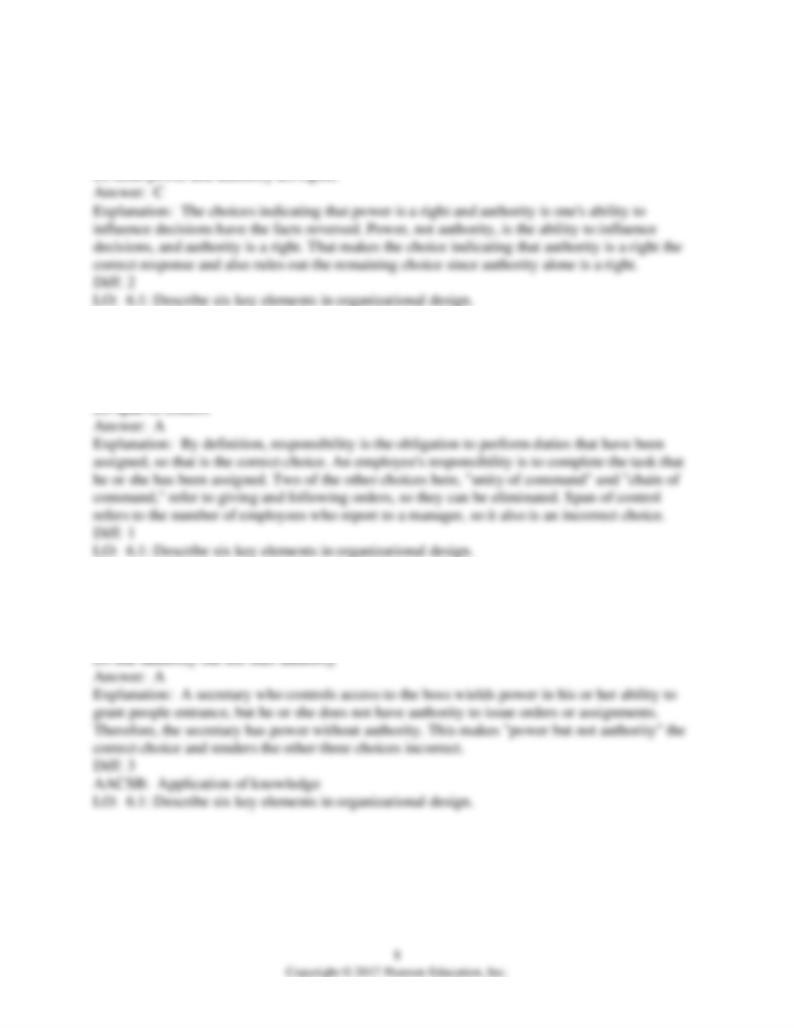
22) Which of the following statements is true?
A) Power is a right.
B) Authority is one's ability to influence decisions.
C) Authority is a right.
23) ________ is the obligation or expectation to perform a duty.
A) Responsibility
B) Unity of command
C) Chain of command
24) The personal secretary of a top manager may have ________.
A) power but not authority
B) authority but not power
C) power and authority
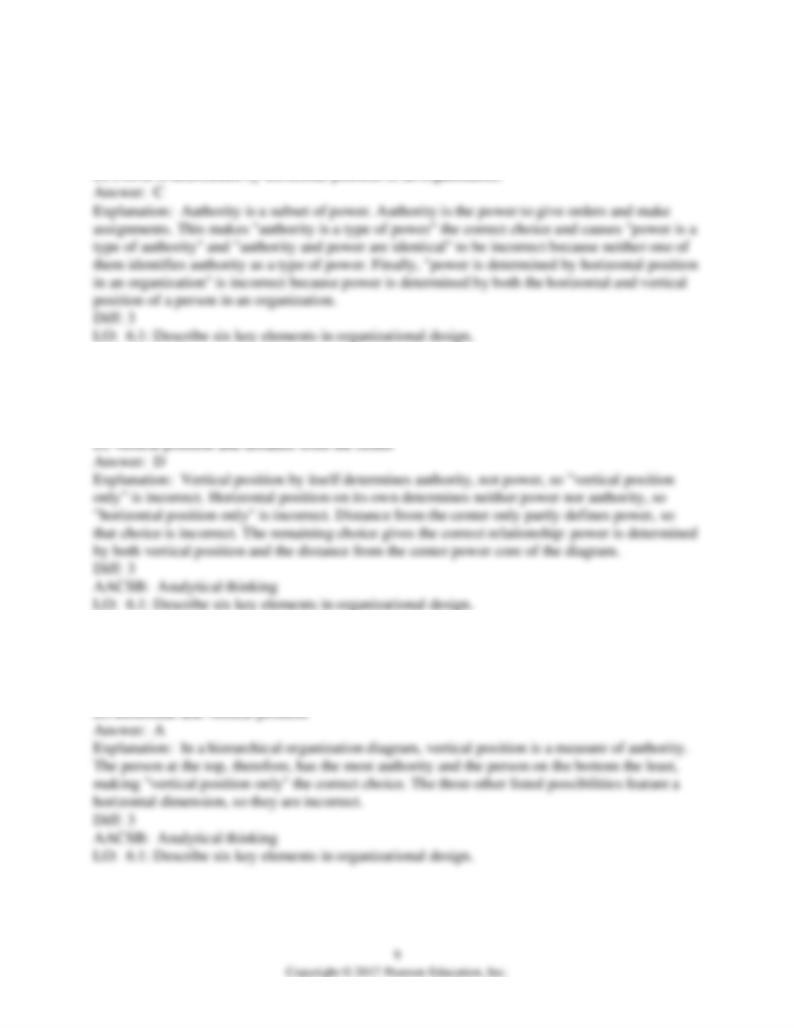
25) Which of the following statements is true?
A) Power is a type of authority.
B) Authority and power are identical.
C) Authority is a type of power.
26) As represented in a power cone, power is based on ________.
A) vertical position only
B) horizontal position only
C) distance from the center only
27) As represented in a hierarchical organization diagram, authority is based on ________.
A) vertical position only
B) horizontal position only
C) distance from the center only
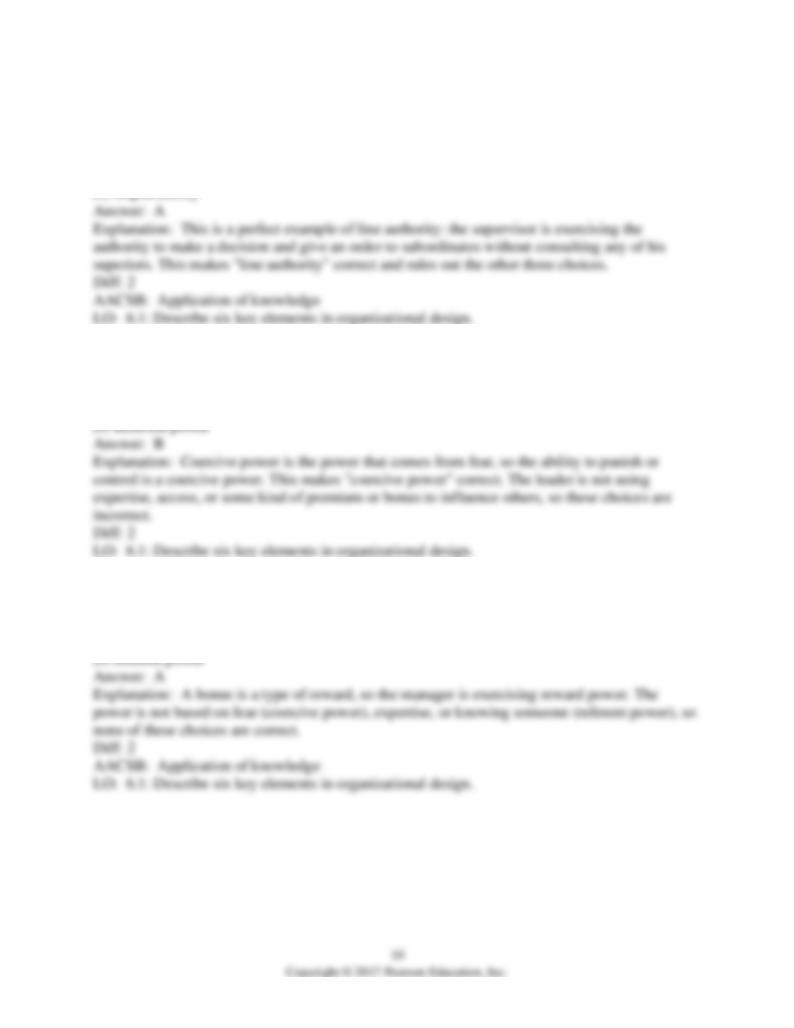
28) A construction site supervisor who sees an impending thunderstorm and tells workers to go
home is demonstrating ________.
A) line authority
B) staff delegation
C) provisional accountability
29) ________ is the power that rests on the leader's ability to punish or control.
A) Reward power
B) Coercive power
C) Expert power
30) A bank manager who passes out bonuses at the end of the year is exercising this.
A) reward power
B) coercive power
C) expert power
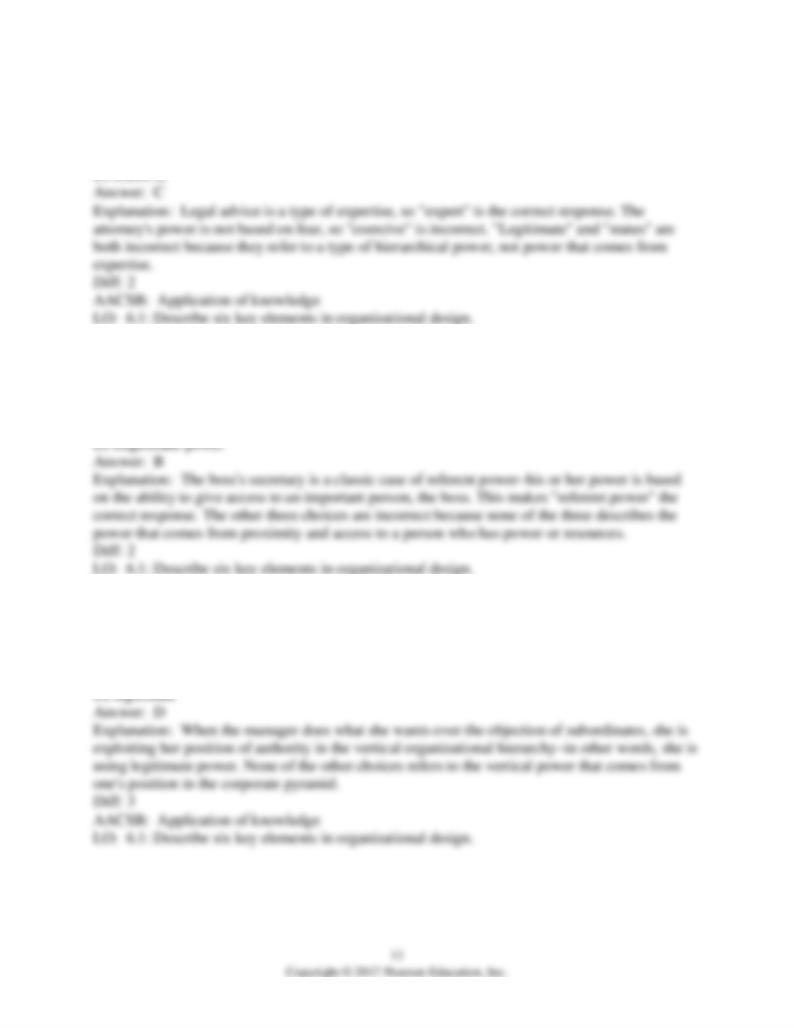
31) Your firm's attorney has ________ power when giving legal advice.
A) legitimate
B) status
C) expert
32) ________ is the power that arises when a person is close to another person who has great
power and authority.
A) Expert power
B) Referent power
C) Reward power
33) When a top manager decides to hire an individual over the objections of her staff, she is
exercising which kind of power?
A) referent
B) expert
C) coercive
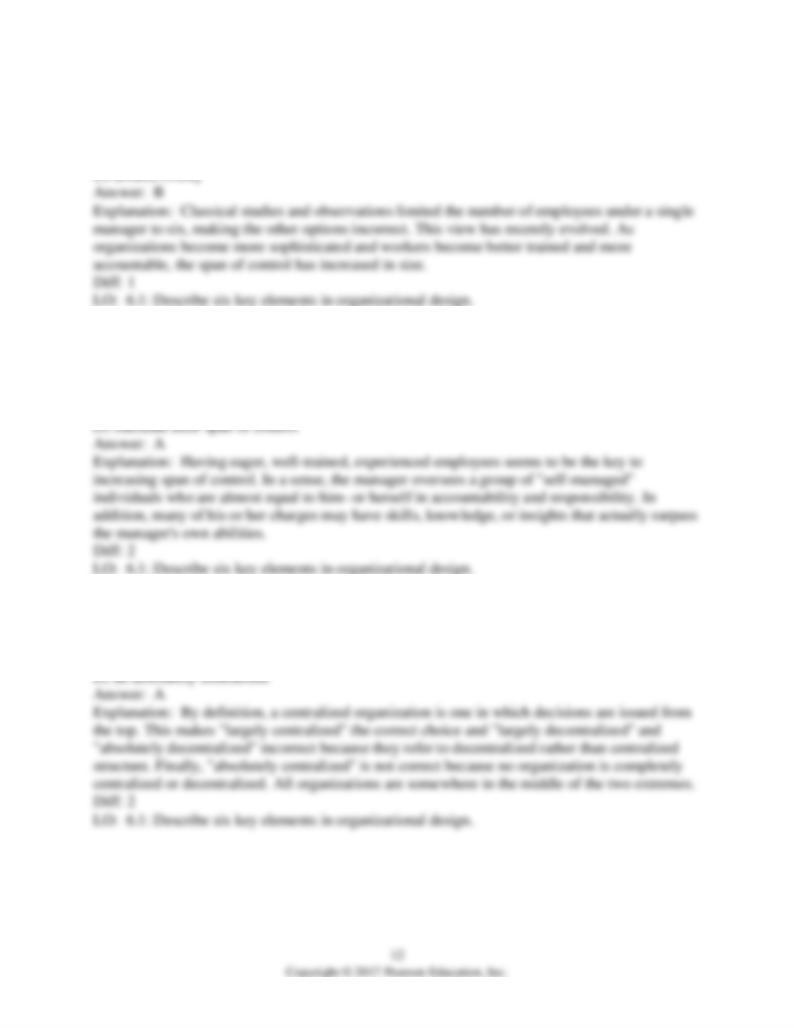
34) The traditional view holds that managers should directly supervise ________ subordinates.
A) no more than three
B) no more than six
C) around twelve
35) Modern managers find that they can ________ if their employees are experienced, well-
trained, and motivated.
A) increase their span of control
B) decrease their span of control
C) eliminate their span of control
36) A traditional "top down" organization is ________ organization.
A) a largely centralized
B) a largely decentralized
C) an absolutely decentralized
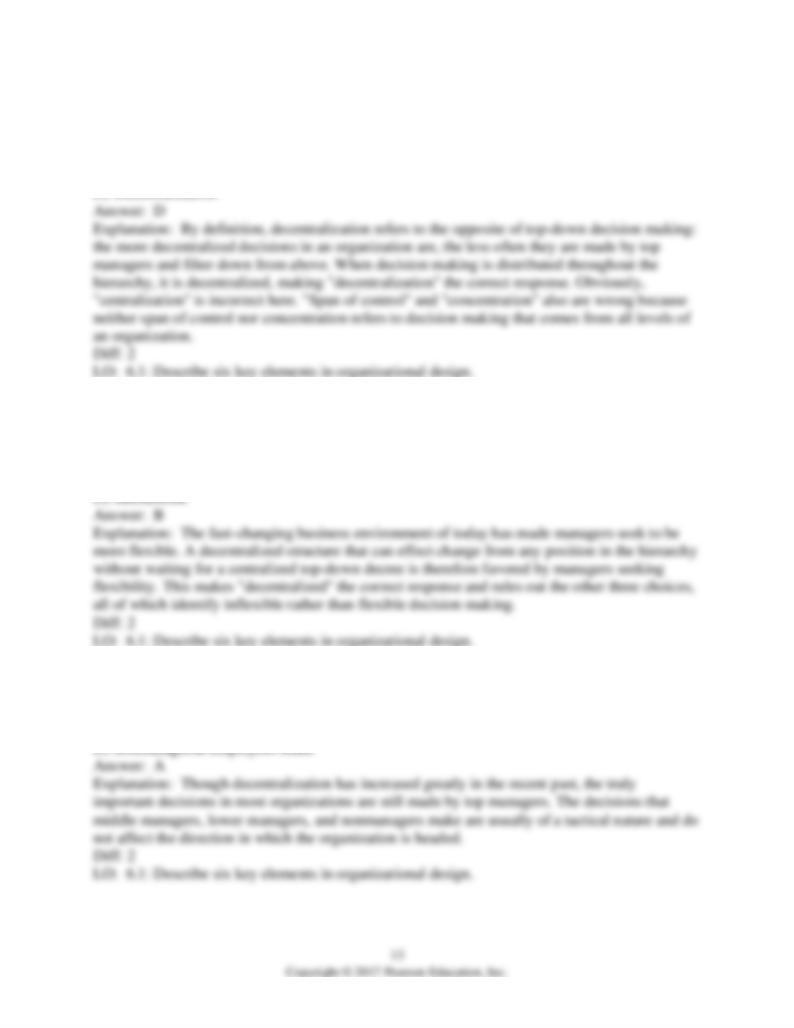
37) ________ reflects the degree to which decision making is distributed throughout the
hierarchy rather than concentrated at the top.
A) Centralization
B) Span of control
C) Concentration
38) In recent years, organizations have become more ________ to be responsive to a dynamic
business environment.
A) centralized
B) decentralized
C) structured
39) In today's decentralized business world, ________ the most important strategic decisions.
A) top managers still primarily make
B) middle managers make
C) lower-level managers make
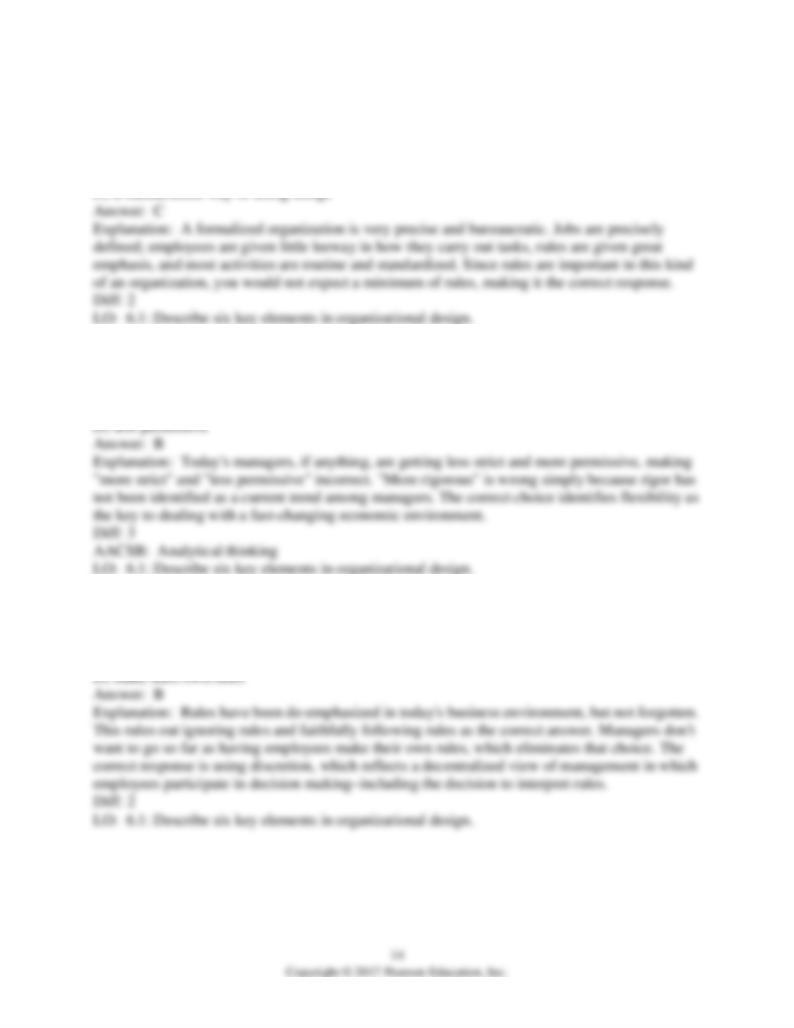
40) All of the following are characteristics of a highly formalized organization EXCEPT
________.
A) explicit job descriptions
B) little discretion for employees
C) minimum number of rules
41) Today's managers are moving away from formalization and trying to be this.
A) more rigorous
B) more flexible
C) more strict
42) Today's managers expect employees to ________.
A) ignore rules for the most part
B) use discretion when it comes to following rules
C) faithfully follow rules even when it may harm the organization
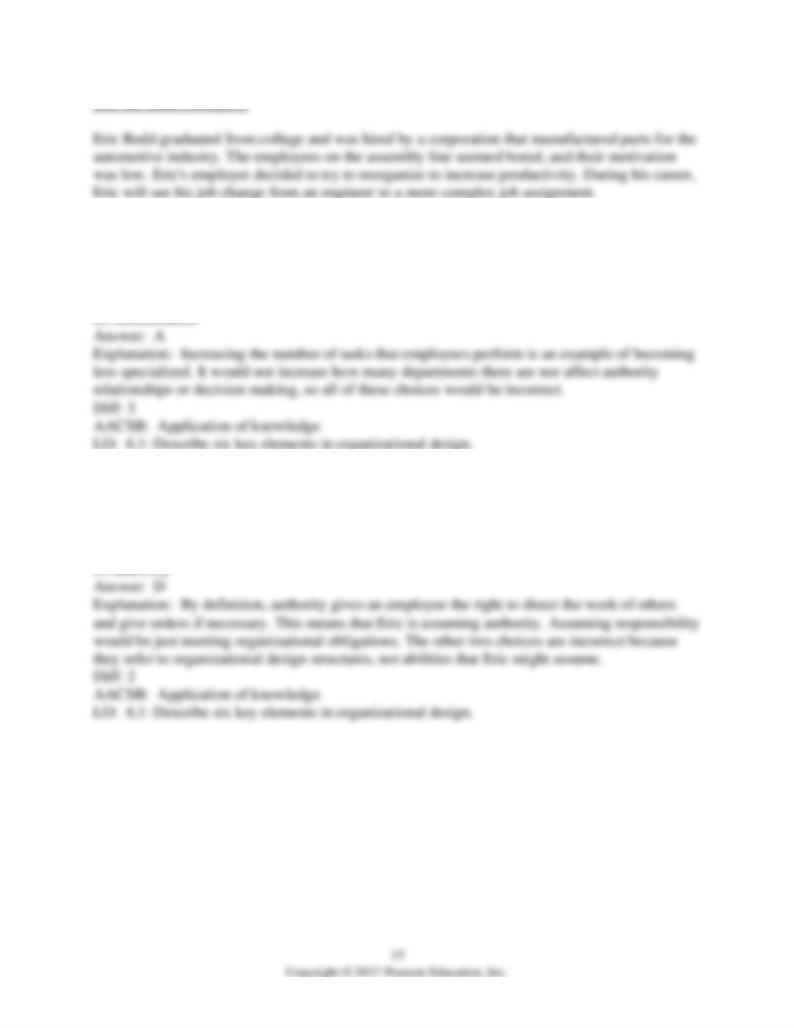
Eric the Redd (Scenario)
43) The jobs of assembly-line employees are to be changed to allow more tasks to be done by
individual workers. This is a reduction in ________.
A) work specialization
B) departmentalization
C) chain of command
44) Eric is offered a chance to help direct the efforts of some employees assigned to his work
group. This is a chance for Eric to experience ________.
A) functional structure
B) divisional structure
C) responsibility
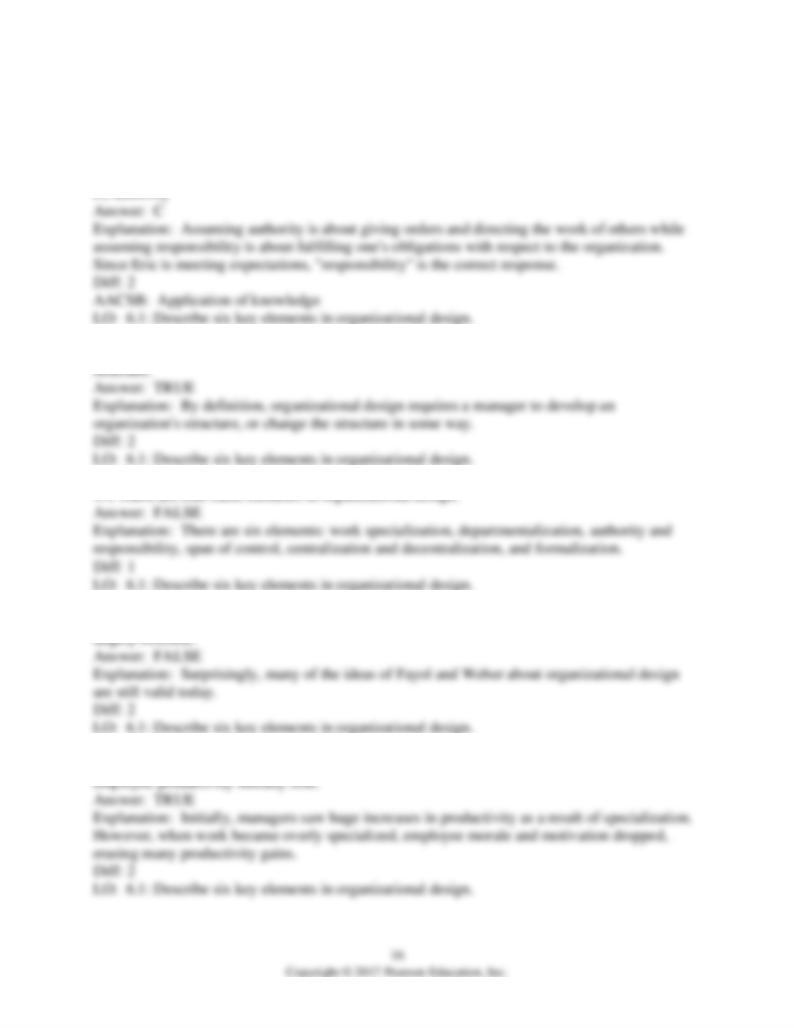
45) Eric sees this new assignment as an increase in ________, or an obligation or expectation for
him to perform at a new level.
A) functional structure
B) divisional structure
C) responsibility
46) Organizational design is the process in which managers change or develop an organization's
48) The original ideas about organizational design formulated by Fayol and Weber are now
49) When work specialization originally began to be implemented early in the twentieth century,
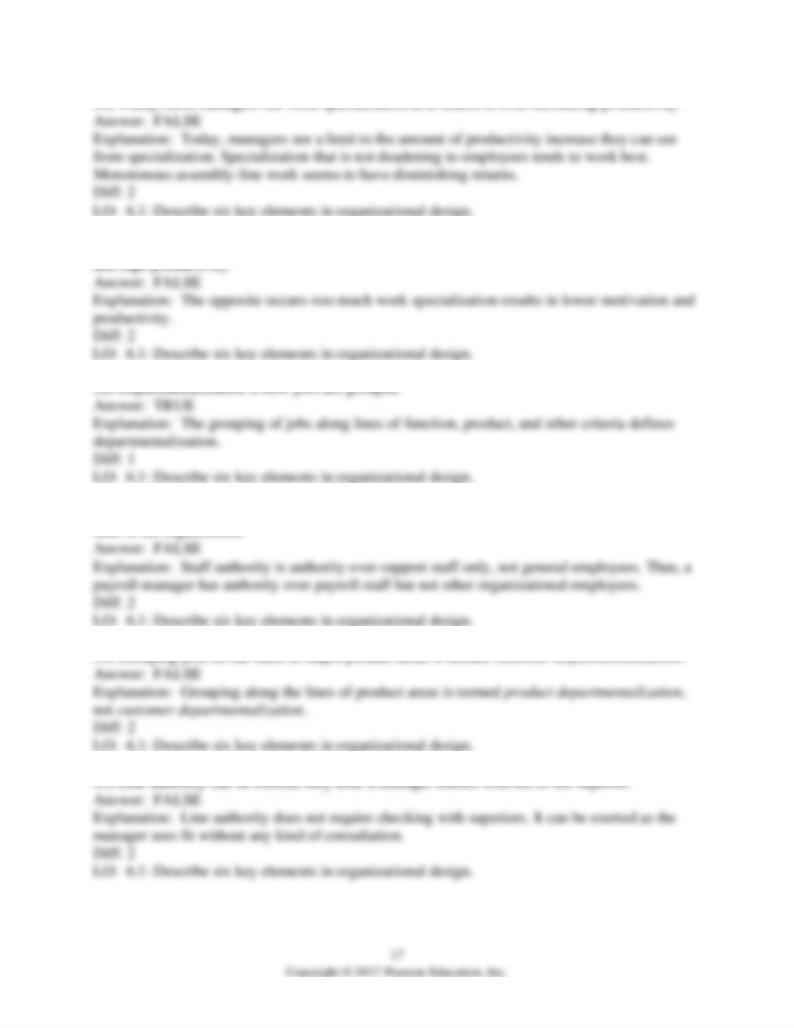
51) The advantage of work specialization is that it always results in high employee motivation
53) Staff authority is the ability to direct the work of any employee who does not have a higher
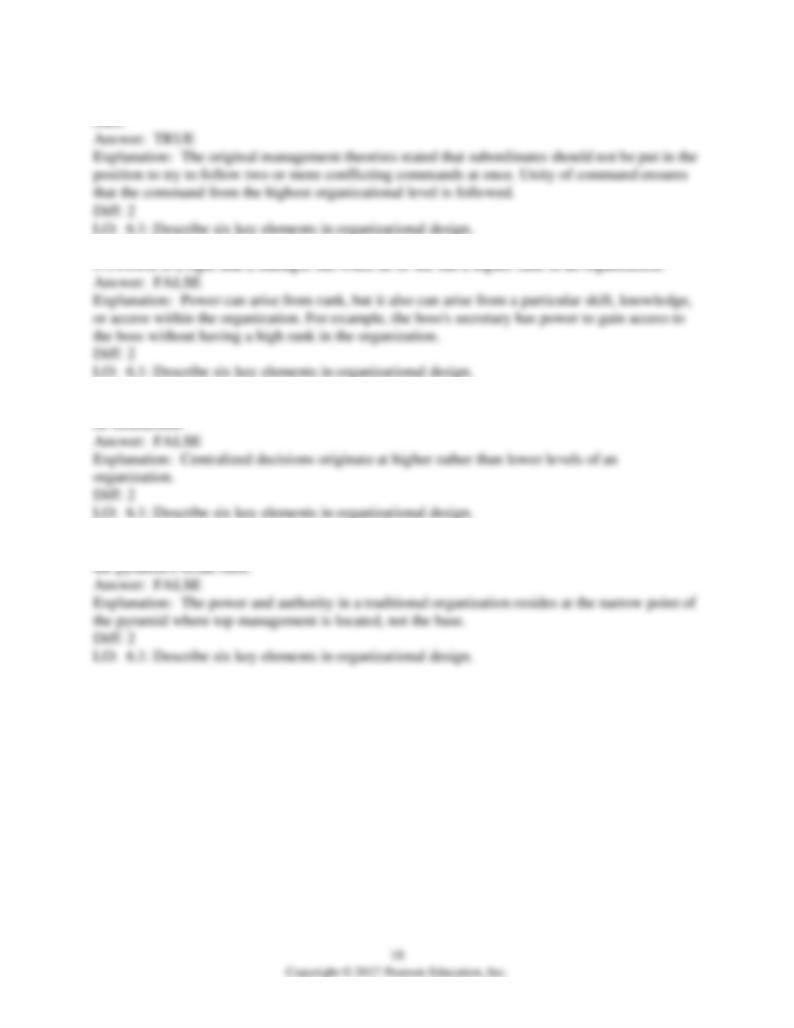
56) Unity of command prevents an employee from trying to follow two conflicting commands at
58) When decisions tend to be made at lower levels in an organization, the organization is said to
59) Traditional organizations are structured in a pyramid, with the power and authority located in
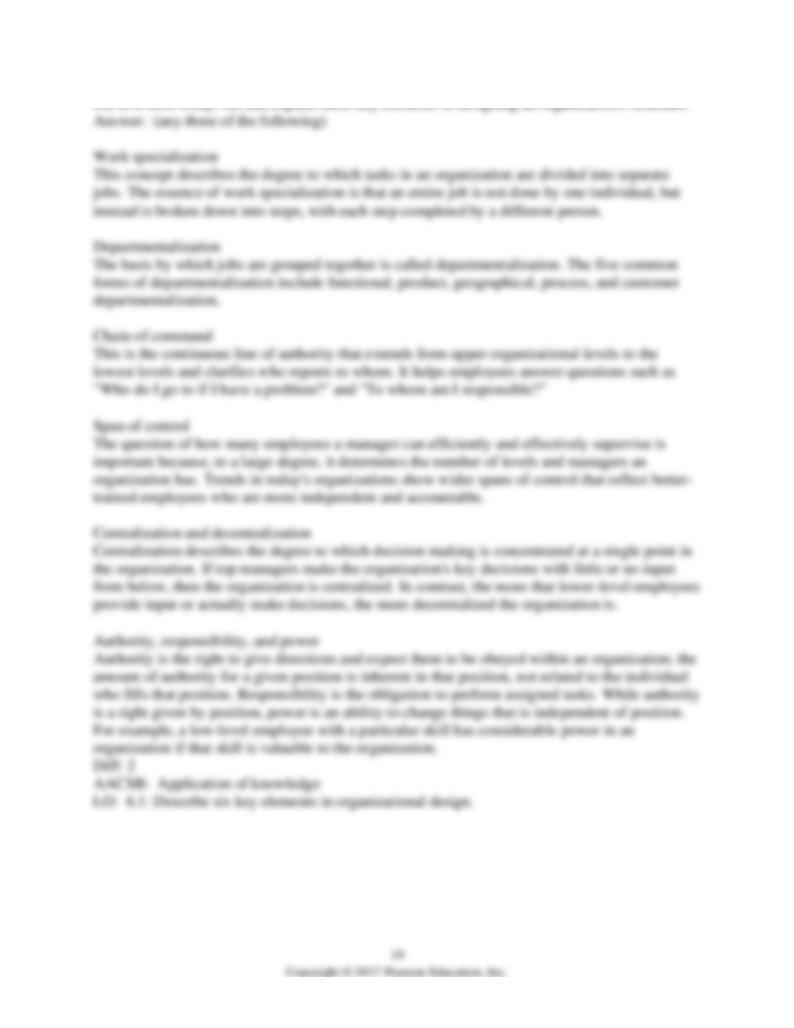

62) A(n) ________ organization has a high degree of specialization, formalization, and
centralization.
A) organic
B) horizontal
C) learning
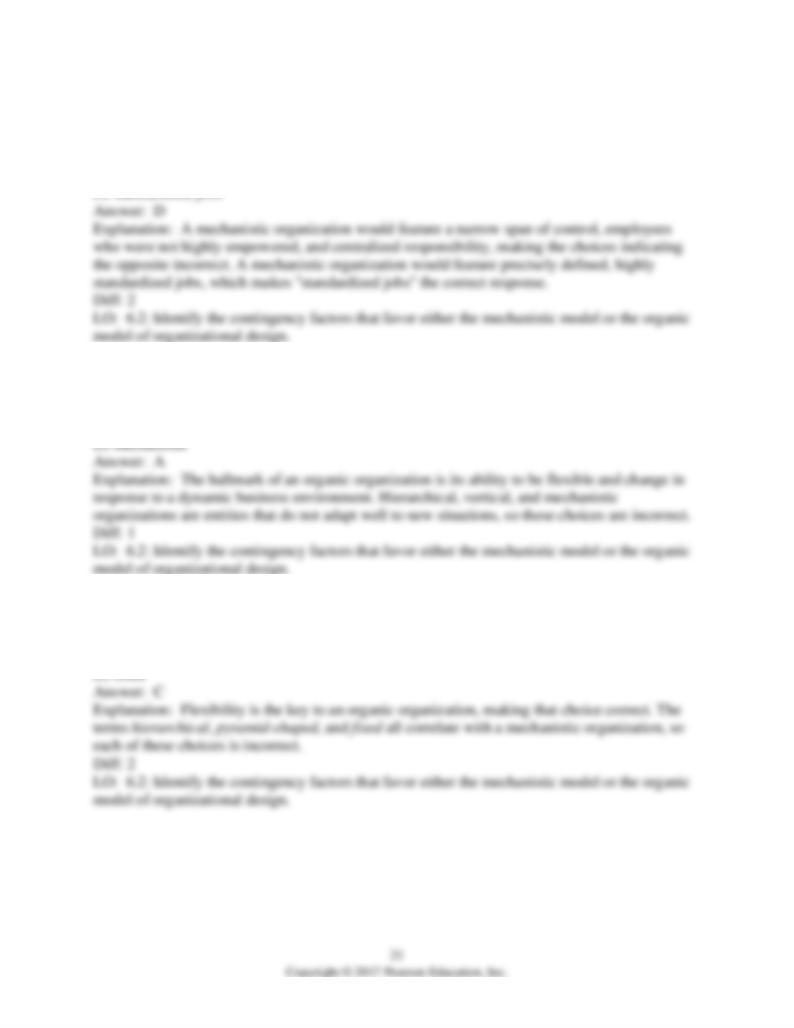
63) Which of the following would likely be found in mechanistic organizations?
A) wide span of control
B) empowered employees
C) decentralized responsibility
64) A(n) ________ organization is able to change rapidly as needs require.
A) organic
B) hierarchical
C) vertical
65) Which term best describes an organic organization?
A) hierarchical
B) pyramid-shaped
C) flexible
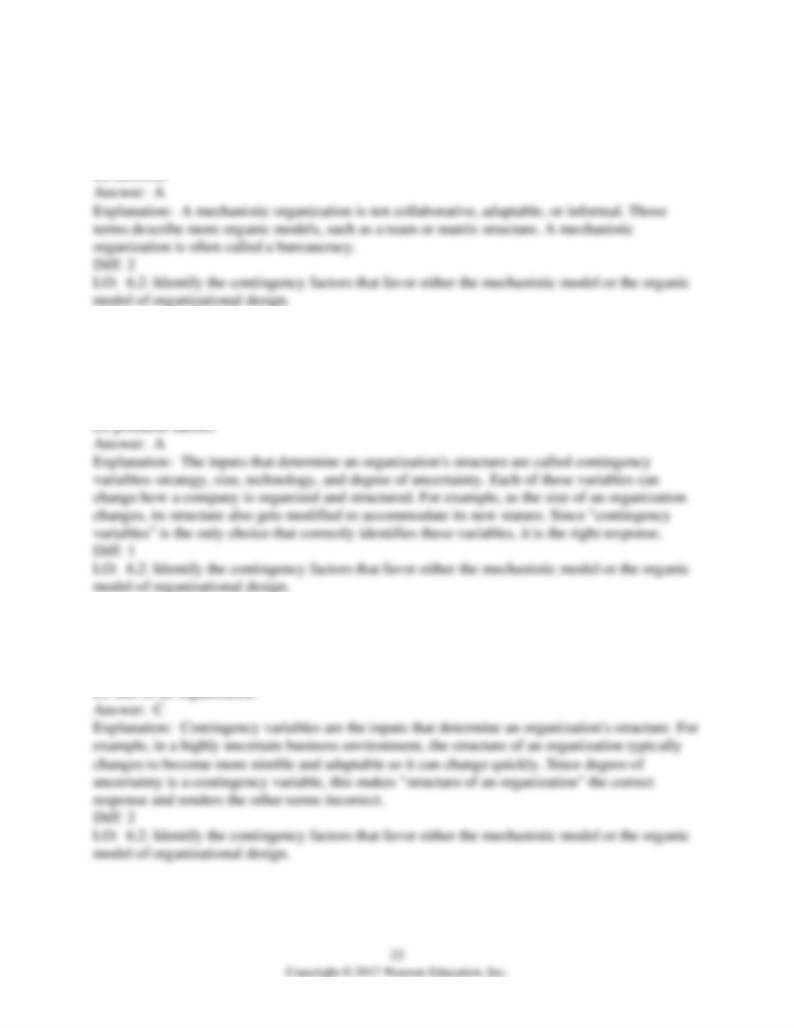
66) Which word best characterizes a mechanistic organization?
A) bureaucracy
B) collaborative
C) adaptable
67) Strategy, size, technology, and the degree of uncertainty in the environment together make
up what are called ________.
A) contingency variables
B) control factors
C) structure variables
68) Together, contingency variables determine the ________.
A) success of an organization
B) culture of an organization
C) structure of an organization

69) A company that is trying to be a leader in innovation within its industry would be most likely
to have this kind of structure.
A) mechanistic
B) organic
C) simple
70) Larger organizations tend to have ________ than smaller organizations.
A) more specialization
B) less departmentalization
C) less centralization
71) As an organization grows to a size of over 2,000 employees, it finds it hard to avoid
becoming more ________.
A) mechanistic
B) organic
C) informal
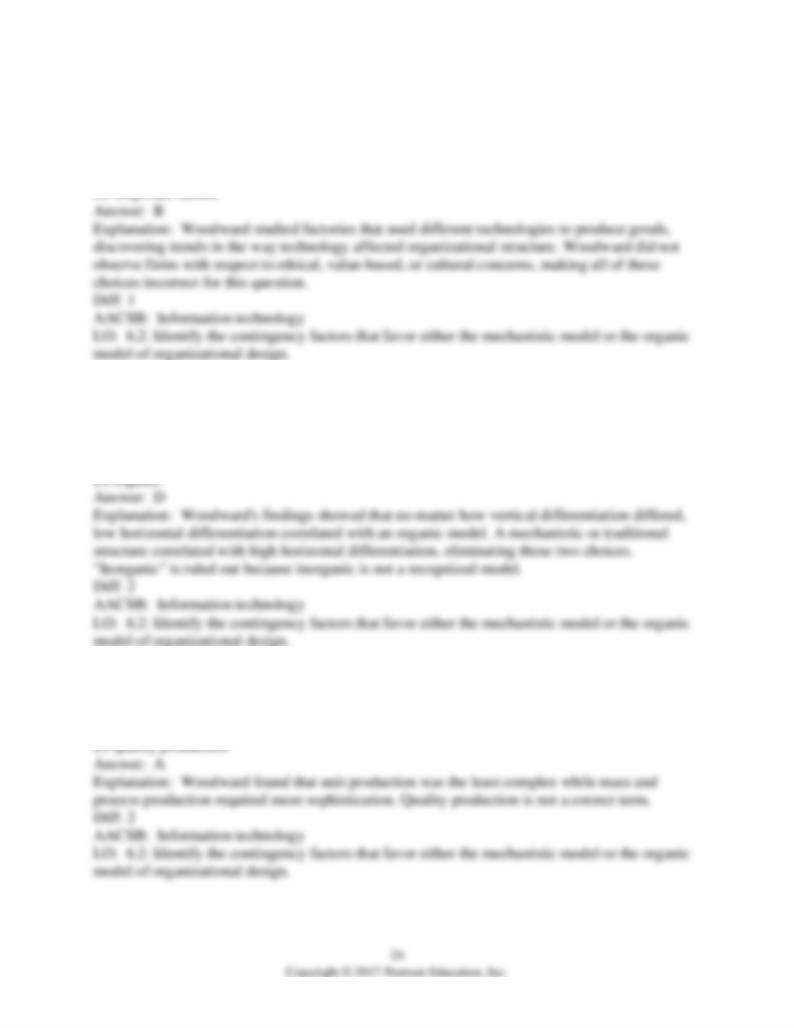
72) Joan Woodward conducted pioneering studies on how this affected the structure of
companies.
A) ethics
B) technology
C) values
73) Recent studies on Woodward's initial research found that if the technology was nonroutine,
this structure worked best.
A) mechanistic
B) traditional
C) inorganic
74) Woodward concluded that the least complex of the technologies was ________.
A) unit production
B) mass production
C) process production
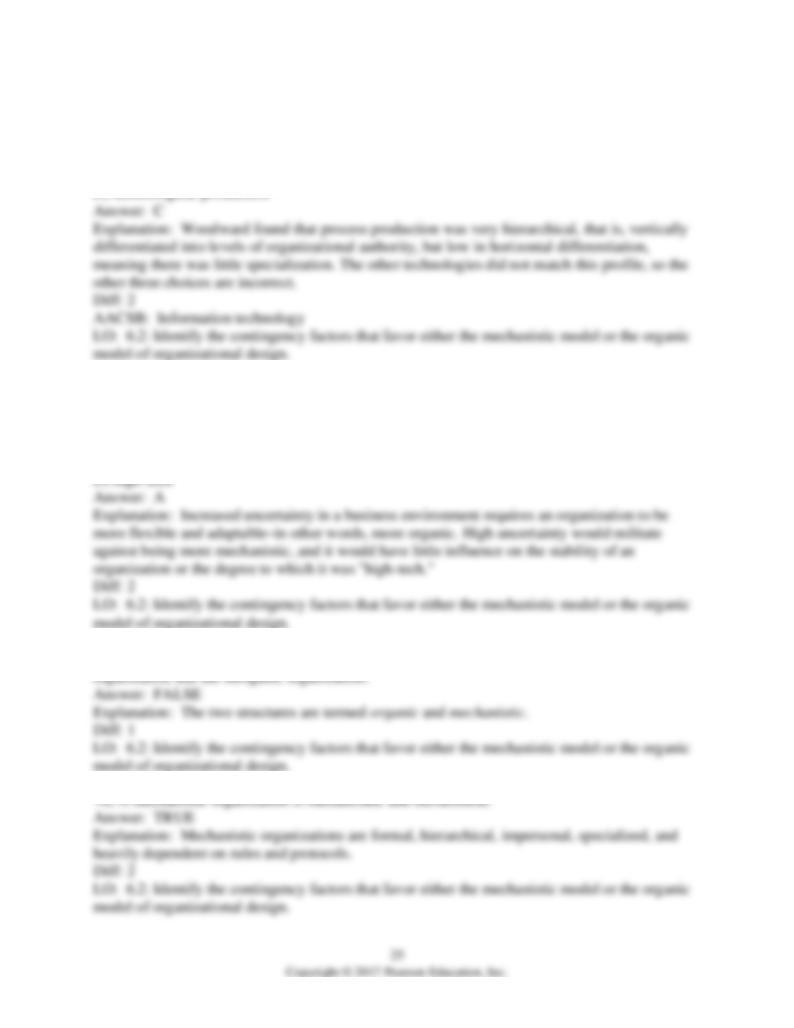
75) In Woodward's study, this type of production was the most complex and the most
sophisticated.
A) unit production
B) mass production
C) process production
76) The greater the environmental uncertainty, the more an organization needs to become
________.
A) organic
B) mechanistic
C) stable
77) The two prevalent organizational structure models in today's world are the organic

80) Innovators need the efficiency, stability, and tight controls of a mechanistic structure rather
83) Woodward and more recent studies have concluded that mass production worked best with
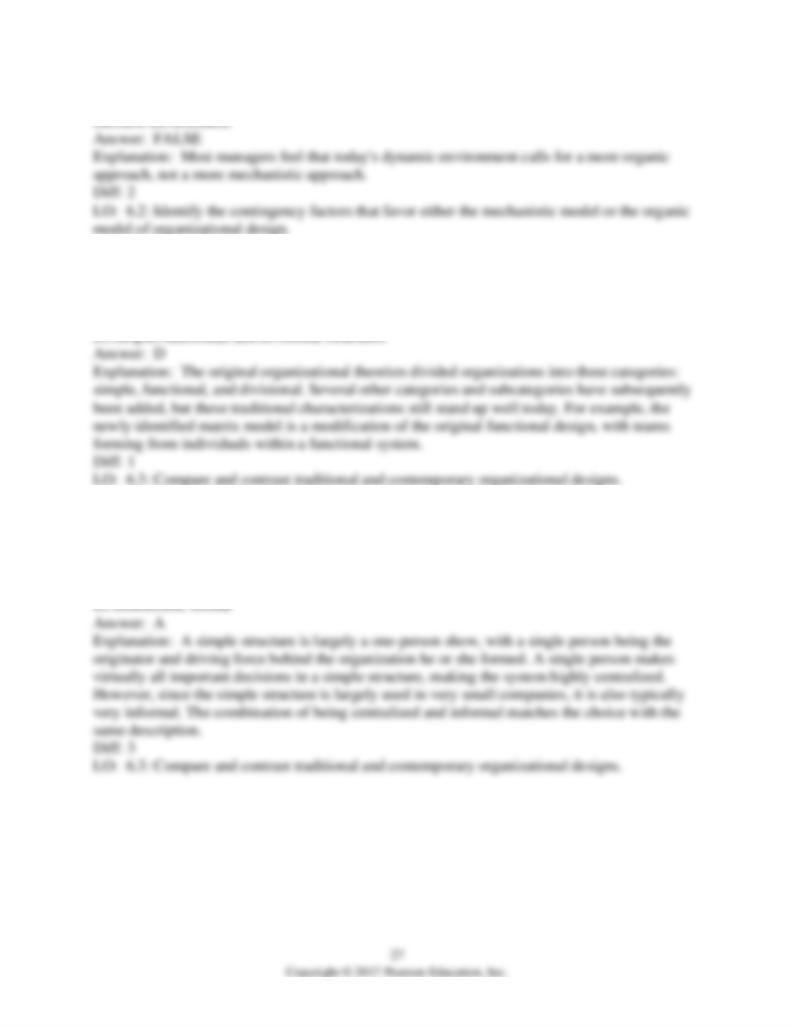
84) The stability of a mechanistic structure seems to work best in today's dynamic and uncertain
85) Traditional organizational designs tend to be more mechanistic and include ________.
A) simple, complex, and divisional structures
B) simple, functional, and dysfunctional structures
C) functional, divisional, and vertical structures
86) A simple structure is ________ like a mechanistic organization, but ________ like an
organic organization.
A) centralized; informal
B) informal; decentralized
C) decentralized; formal
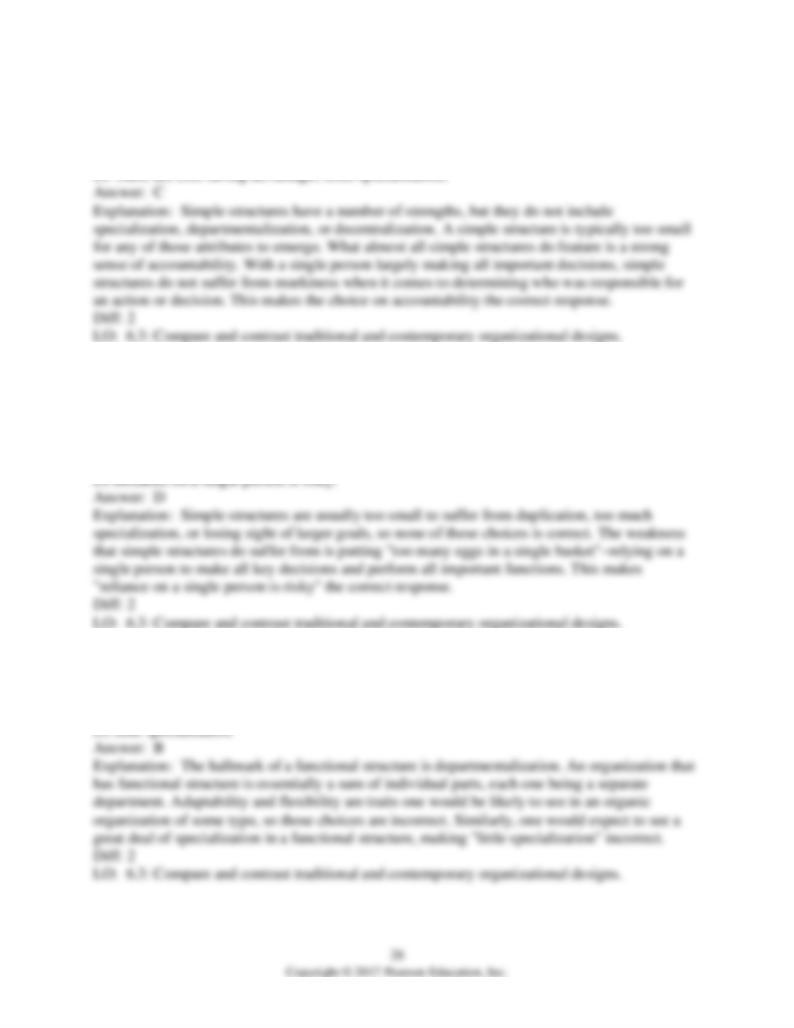
87) What is a strength of a simple structure?
A) Employees are grouped with others who have similar tasks.
B) Power and authority are widely distributed.
C) Accountability is clear.
88) What is a weakness of a simple structure?
A) Duplication of activities and resources increases costs and reduces efficiency.
B) Functional specialists become insulated and have little understanding of what other units are
doing.
C) Pursuit of functional goals can cause managers to lose sight of what is best for the overall
organization.
89) This is a key characteristic in an organization with a functional structure.
A) adaptability
B) departmentalization
C) flexibility
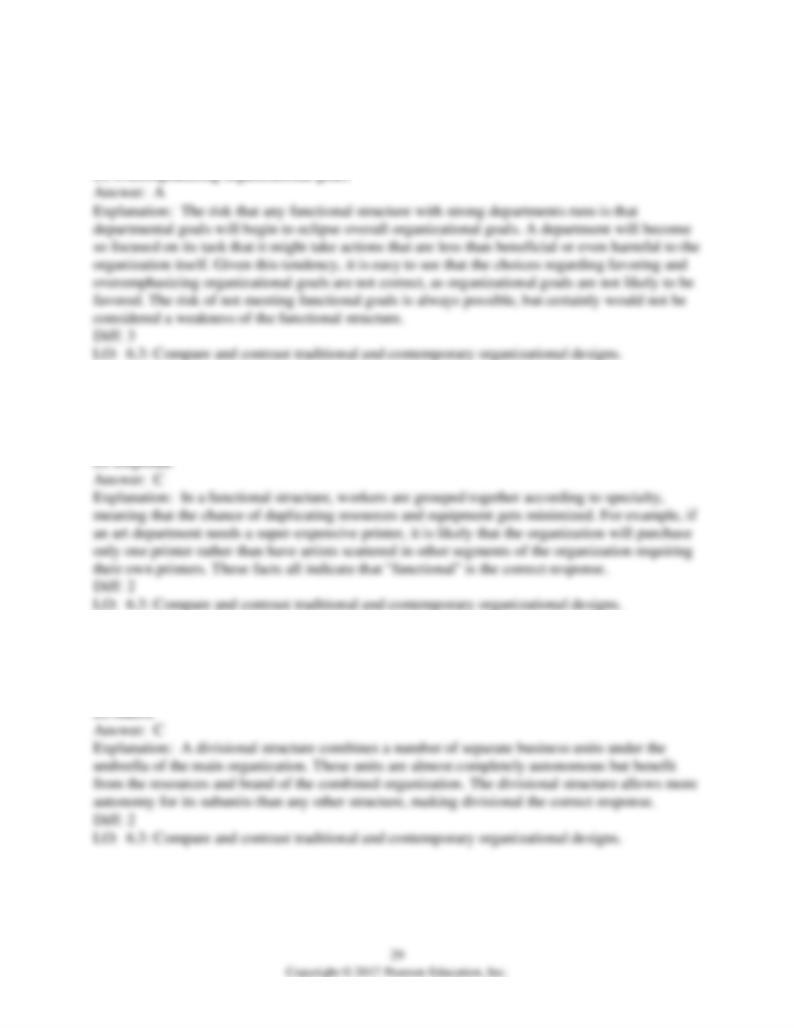
90) This is a weakness of a functional structure.
A) favoring functional goals over organizational goals
B) favoring organizational goals over functional goals
C) failing to attain functional goals
91) Avoiding redundancy is a strength of which structure?
A) simple
B) divisional
C) functional
92) In a ________ structure each business unit has complete autonomy to reach its goals.
A) simple
B) functional
C) divisional
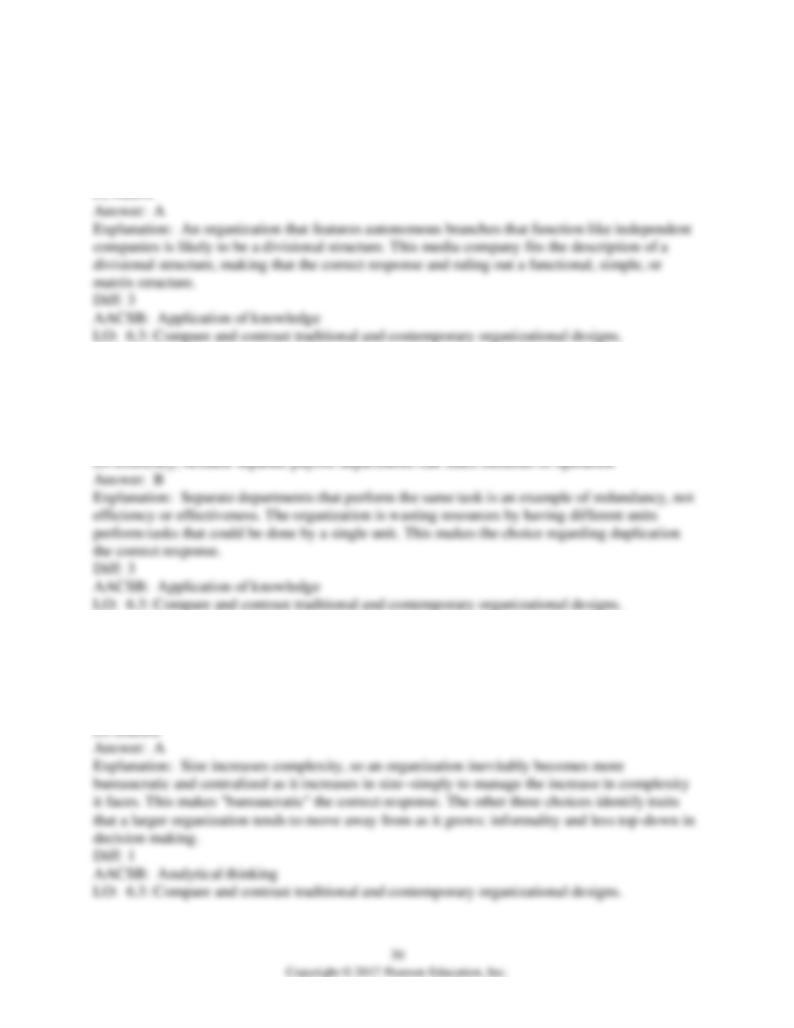
93) A media company that has separate, autonomous companies for movies, TV, Internet, and
print journalism is most likely a ________ structure.
A) divisional
B) functional
C) simple
94) Having separate payroll departments in each division of a divisional structure is an example
of which of the following?
A) efficiency, because payroll departments compete
B) duplication, because a single payroll department could do the job
C) effectiveness, because separate payroll departments create jobs
95) As the number of employees in an organization grows, structure tends to become more
________.
A) bureaucratic
B) informal
C) decentralized
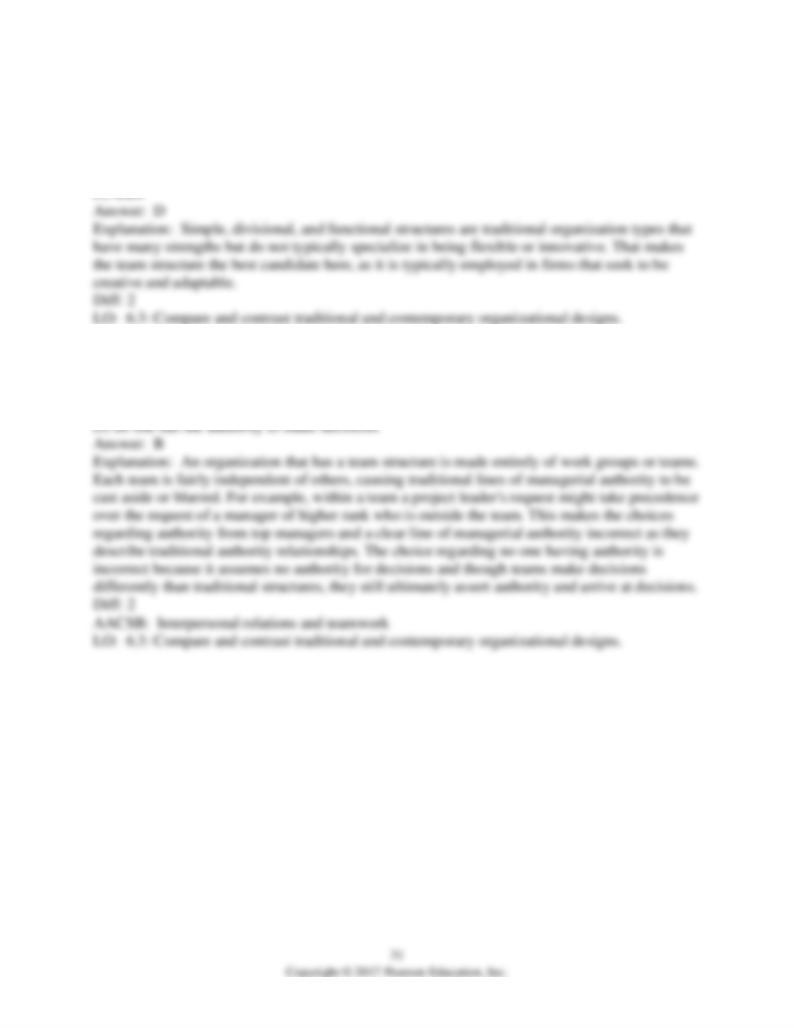
96) Looking for ways to make their organization more flexible and innovative, today's managers
may choose this kind of structure.
A) simple
B) divisional
C) functional
97) In a team structure, ________.
A) there is a clear line of managerial authority
B) there is no clear line of managerial authority
C) authority comes from top managers only
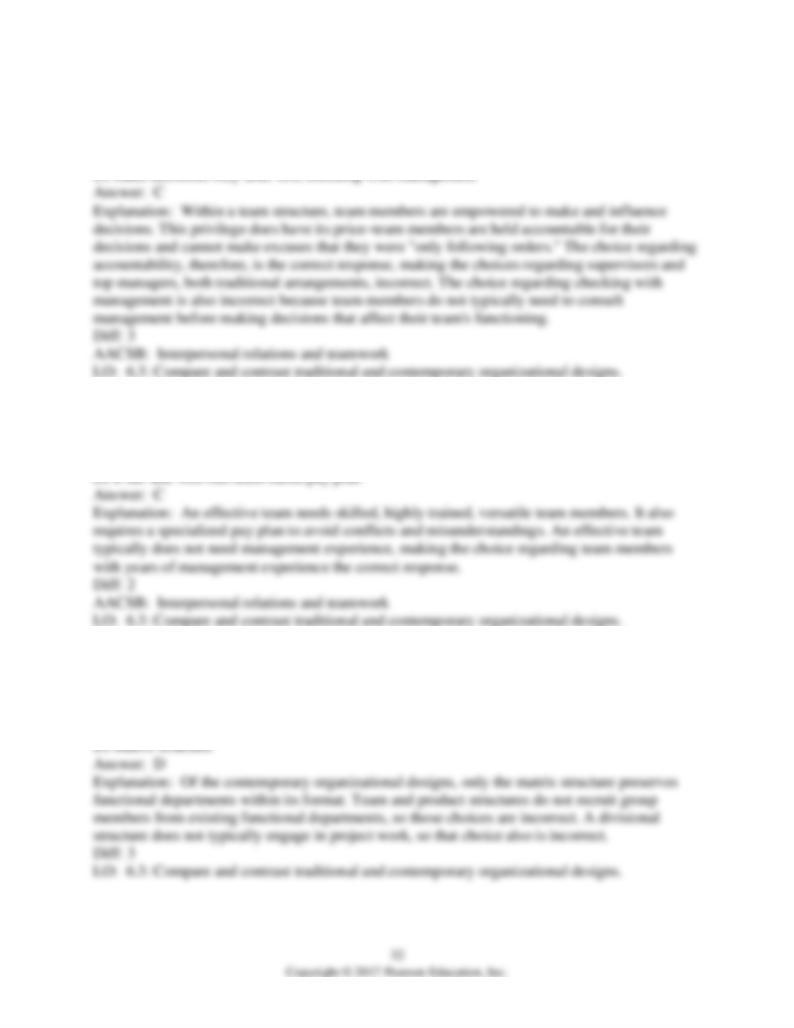
98) In a team structure, team members ________.
A) are subject to decisions made by their supervisors
B) can influence decisions made by top managers
C) make decisions and are accountable for their decisions
99) All of the following are necessary for successful team structure EXCEPT ________.
A) well-trained team members
B) team members with cross-functional skills
C) team members with years of management experience
100) In a ________, employees are recruited from functional departments to work on a specific
project for a limited time period.
A) team structure
B) divisional structure
C) product structure
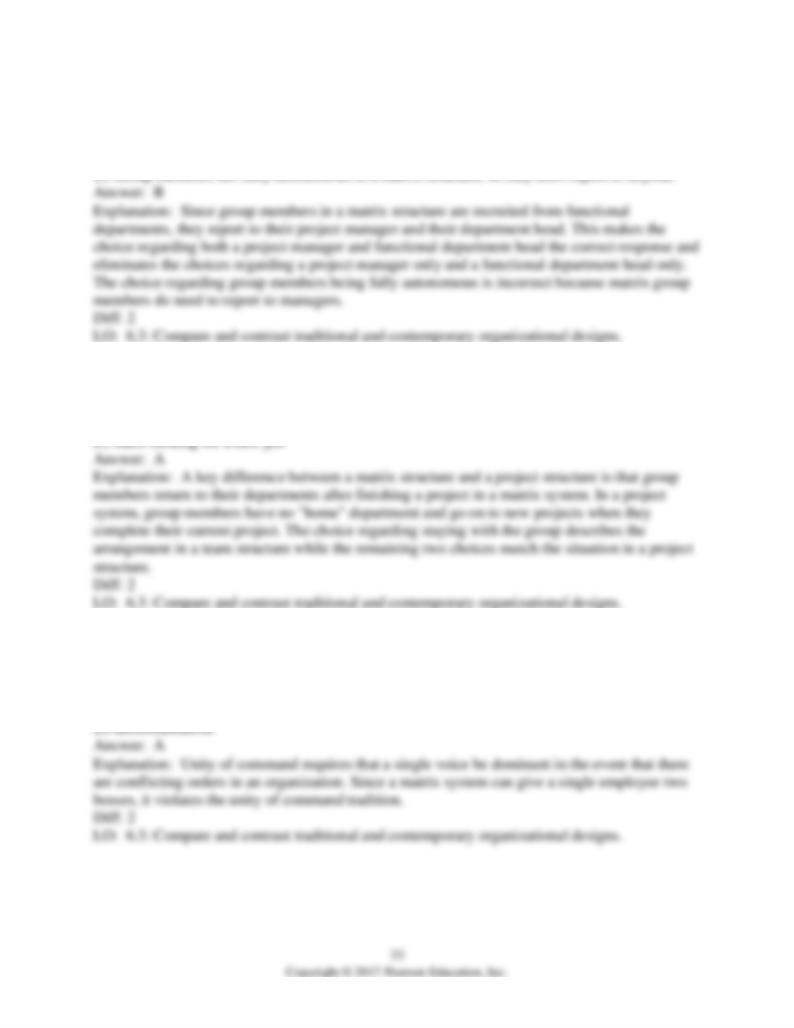
101) In a matrix structure, a group member will typically report to ________.
A) a project manager only
B) both a project manager and functional department head
C) a functional department head only
102) When a group member in a matrix structure finishes a project, he or she ________.
A) returns to his or her functional department
B) stays with the group to take on a new project
C) enters a pool of available employees from the entire organization
103) By giving employees two direct superiors, a matrix structure violates this key element of
organizational design.
A) unity of command
B) chain of command
C) span of management
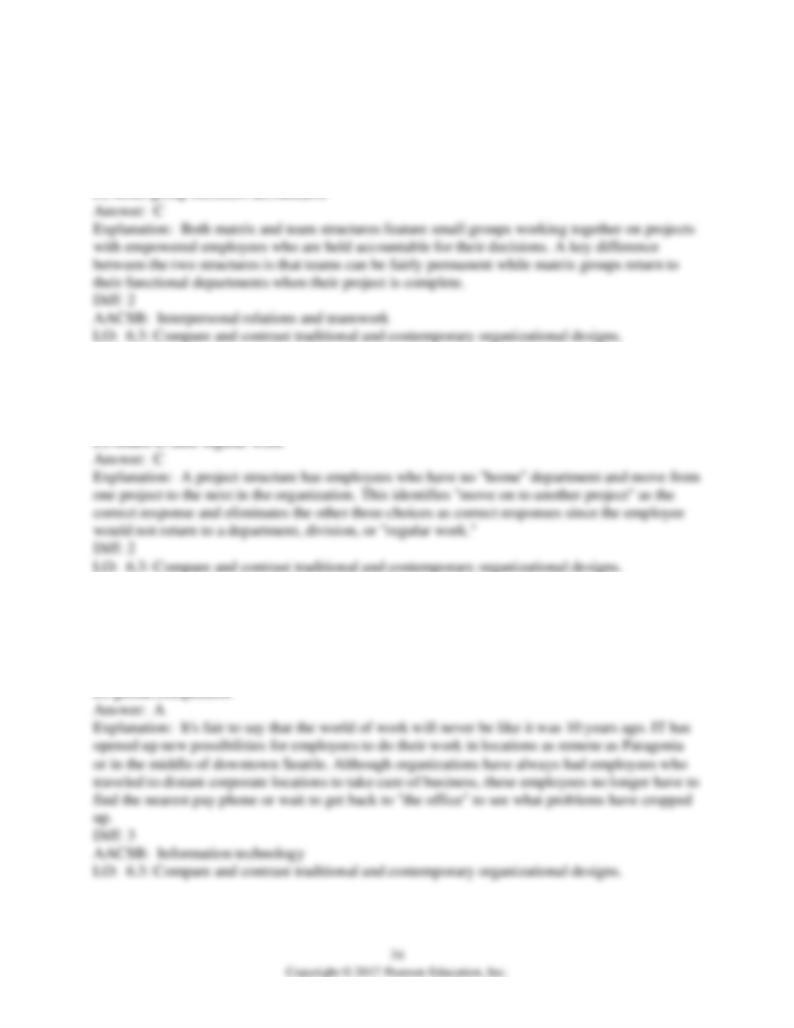
104) A key difference between a team structure and a matrix structure is that a team structure
________ while a matrix structure does not.
A) empowers group members
B) works on projects
C) has fairly permanent groups or teams
105) In a project structure, when employees finish a project they ________.
A) return to their department
B) return to a different division
C) move on to another project
106) Which of the following areas has opened up new possibilities for how and where employees
work?
A) information technology
B) human resources
C) organizational design

107) Which of the following is the biggest concern when doing work at anytime and anywhere?
A) employee payroll
B) security
C) employee accountability
108) Boundaryless organizations try to eliminate ________ within their organization.
A) horizontal specialization and vertical hierarchy
B) horizontal specialization only
C) vertical hierarchy only
109) A virtual organization is essentially ________ who come together for a particular project.
A) a group of employees from a single company
B) a group of free agents
C) a team of employees from different departments of a company
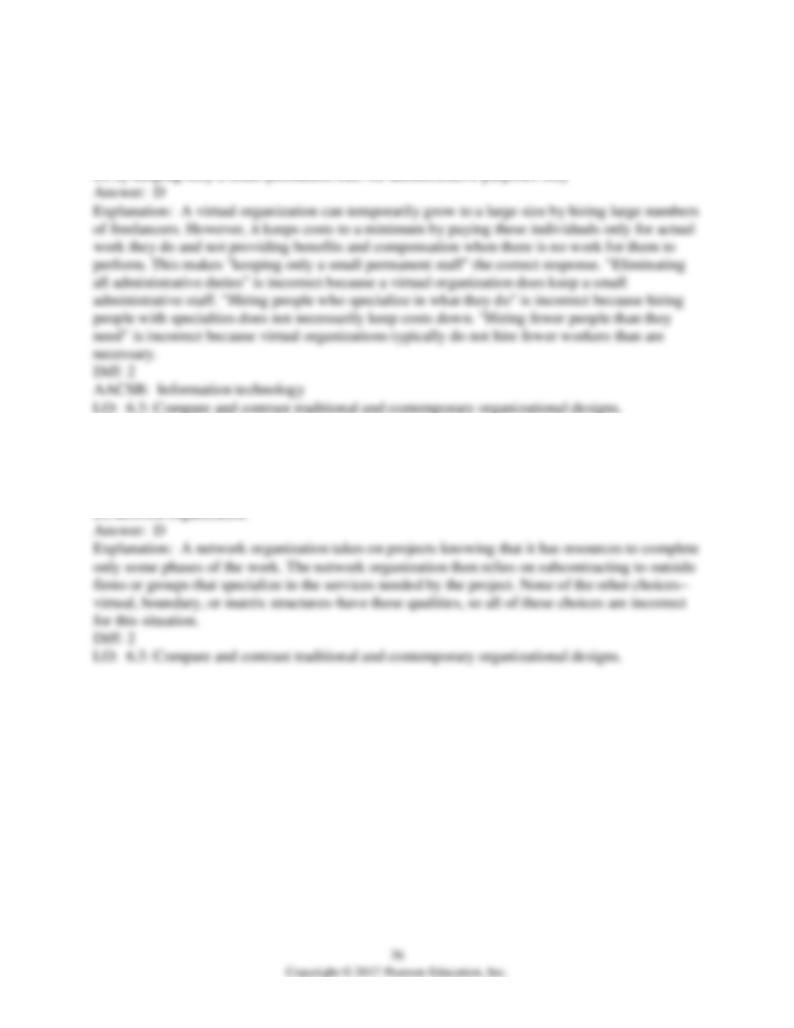
110) How does a virtual organization save on costs?
A) by hiring people who specialize in what they do
B) by hiring fewer people than they need and making them work much longer hours
C) by eliminating all administrative duties
111) A ________ subcontracts part of a project to outside suppliers.
A) virtual organization
B) boundary organization
C) matrix structure
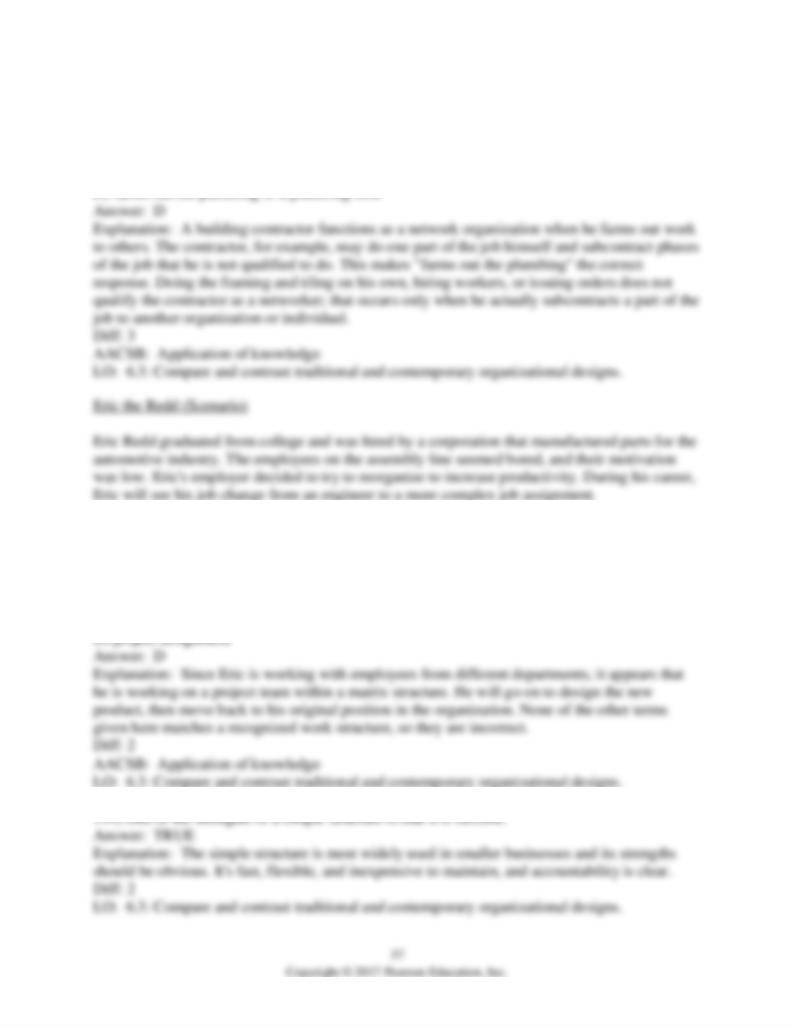
112) A building contractor follows the network organization model when he does which of the
following?
A) does the framing and tiling by himself
B) hires three workers to help with framing
C) gives orders to workers
113) Eric, who is trained as an engineer, is now in a group with production workers and
marketing specialists from different departments designing a new product that the company plans
to offer. This situation could be described as a(n) ________.
A) alternative assignment
B) collective assignment
C) advanced assignment
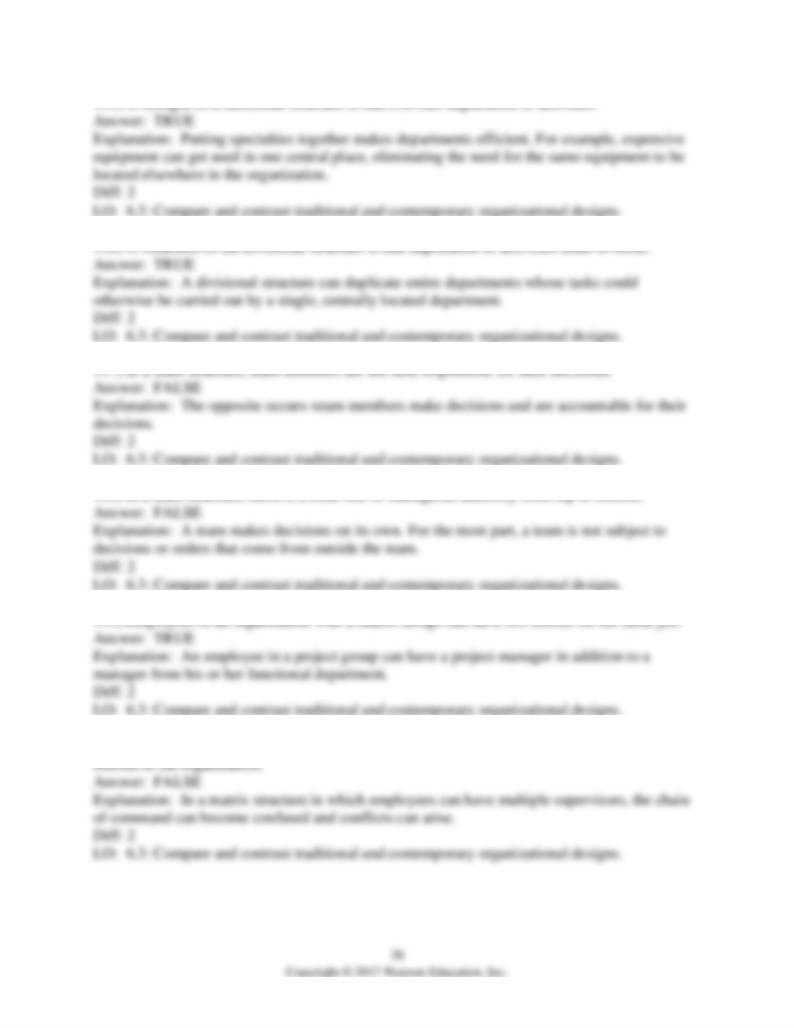
120) A significant advantage of the matrix structure is the clear chain of command from top to
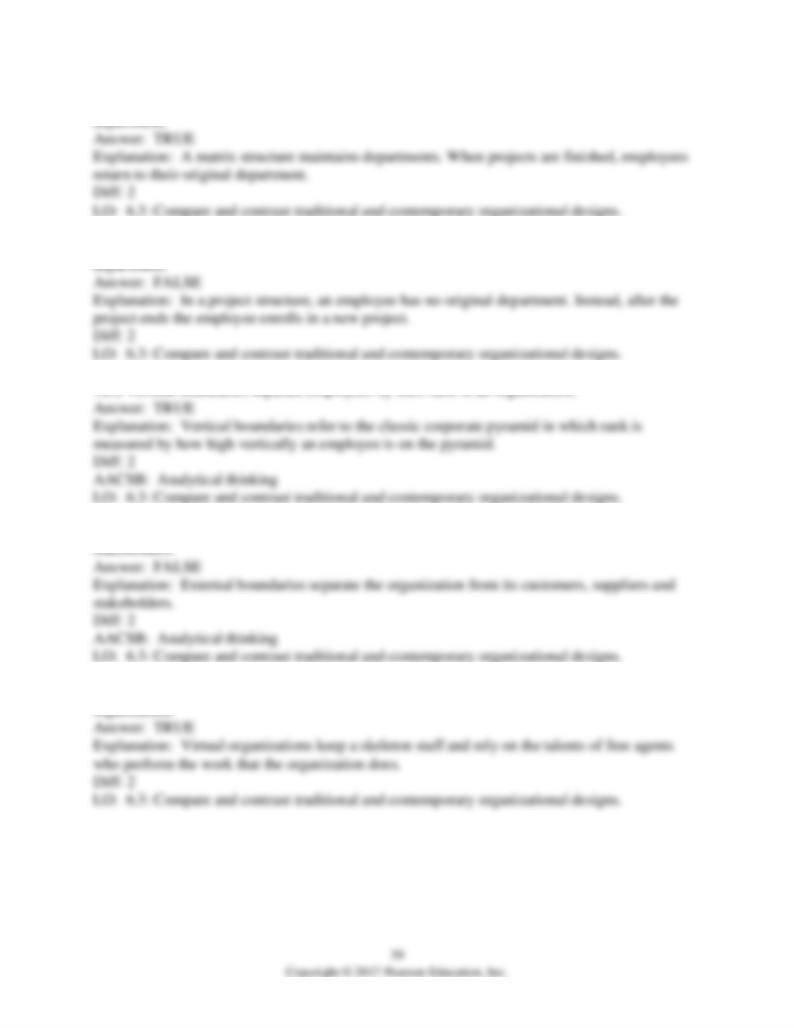
121) When employees in a matrix structure finish a project, they go back to their functional
122) When employees in a project structure finish a project, they go back to their original
124) Internal boundaries separate the organization from its customers, suppliers and
125) A virtual organization relies on free agents who have no permanent status or position in the
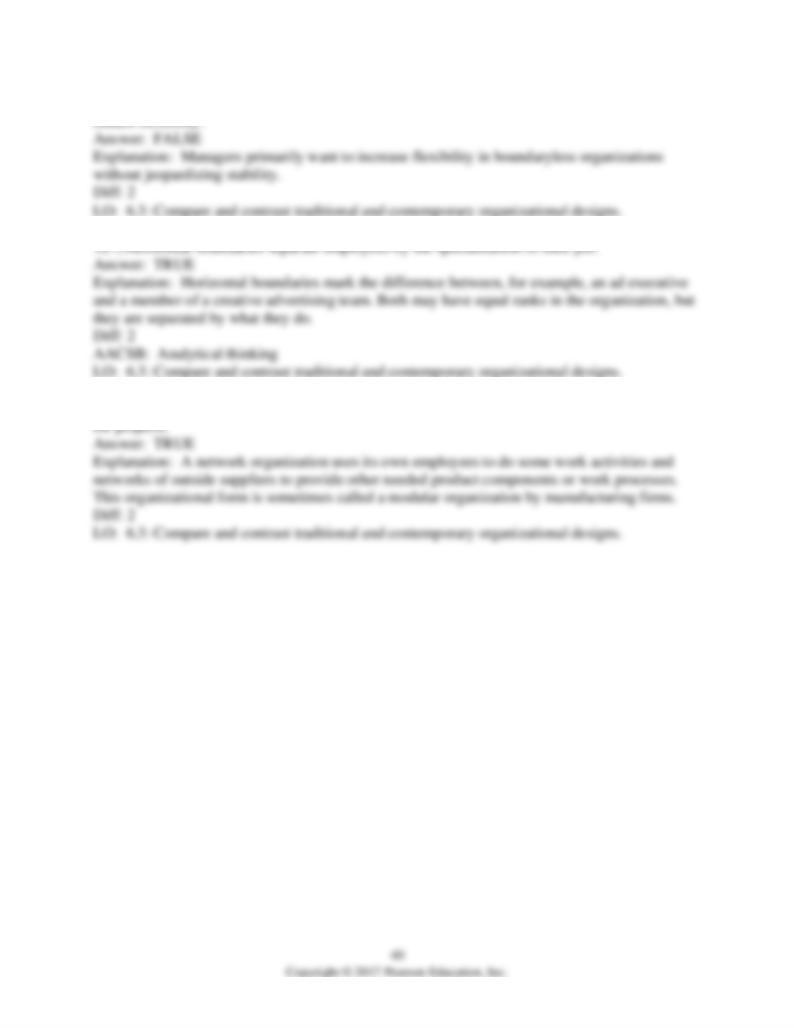
126) Managers want to eliminate boundaries in organizations primarily to increase stability and
128) A network organization uses its own employees and outside suppliers to provide manpower
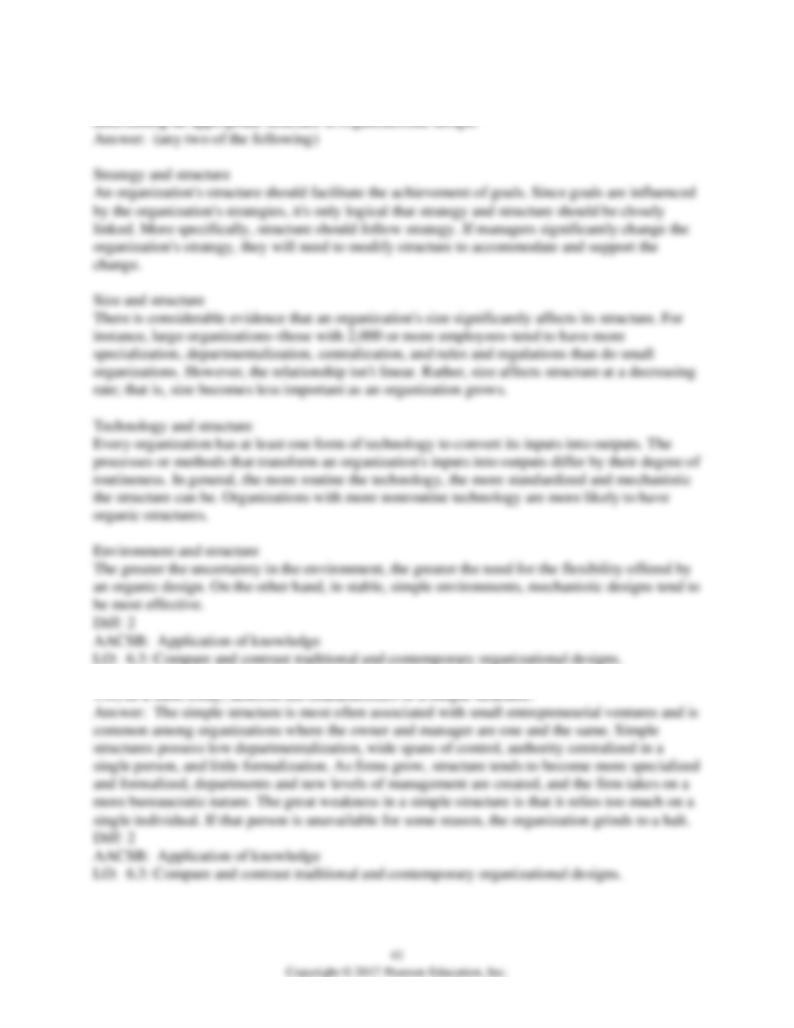
129) In a short essay, list and discuss two contingency variables that should be considered in
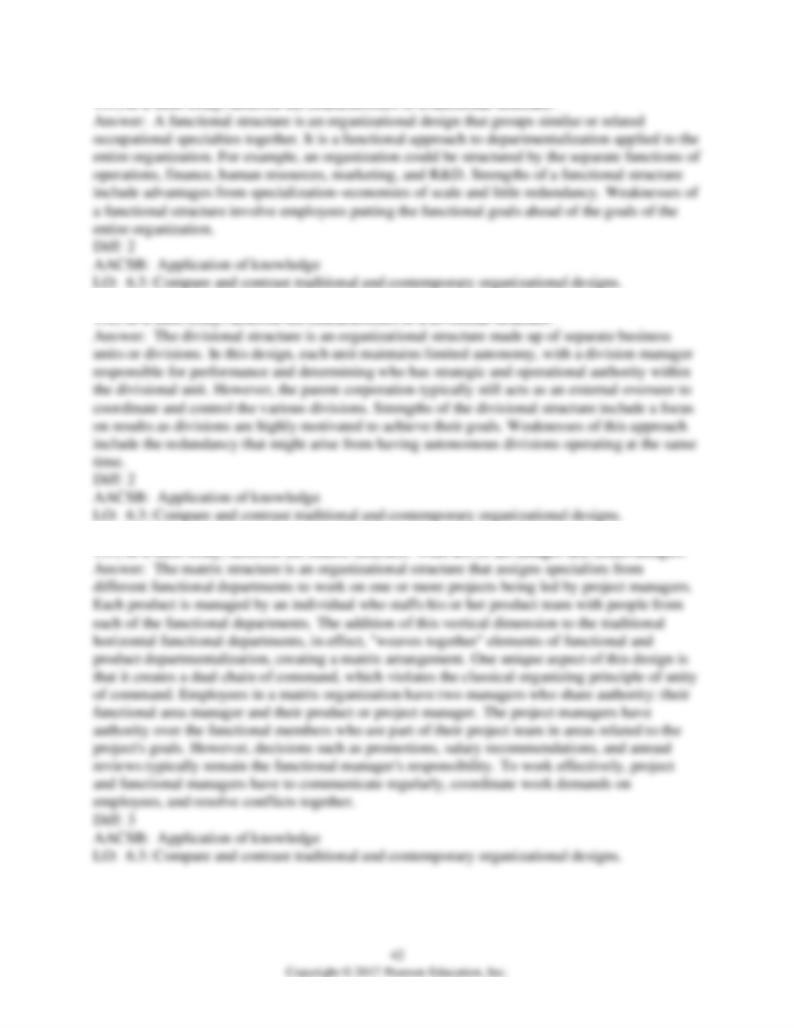
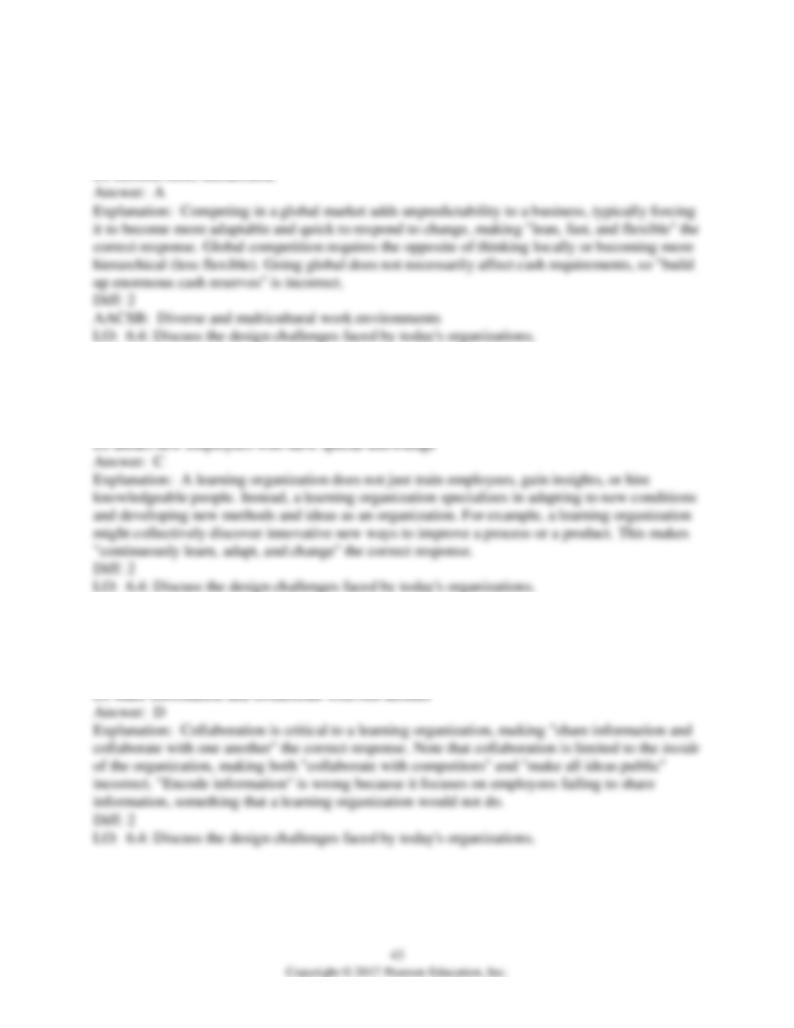
134) Global competition forces firms to ________.
A) become lean, fast, and flexible
B) build up enormous cash reserves
C) think locally
135) A learning organization develops the capability to ________.
A) add new training programs to keep employees up to date
B) accept the conventional wisdom of the industry
C) continuously learn, adapt, and change
136) A learning organization requires employees to ________.
A) encode information to prevent competitors from stealing ideas
B) collaborate with competitors
C) make all ideas public
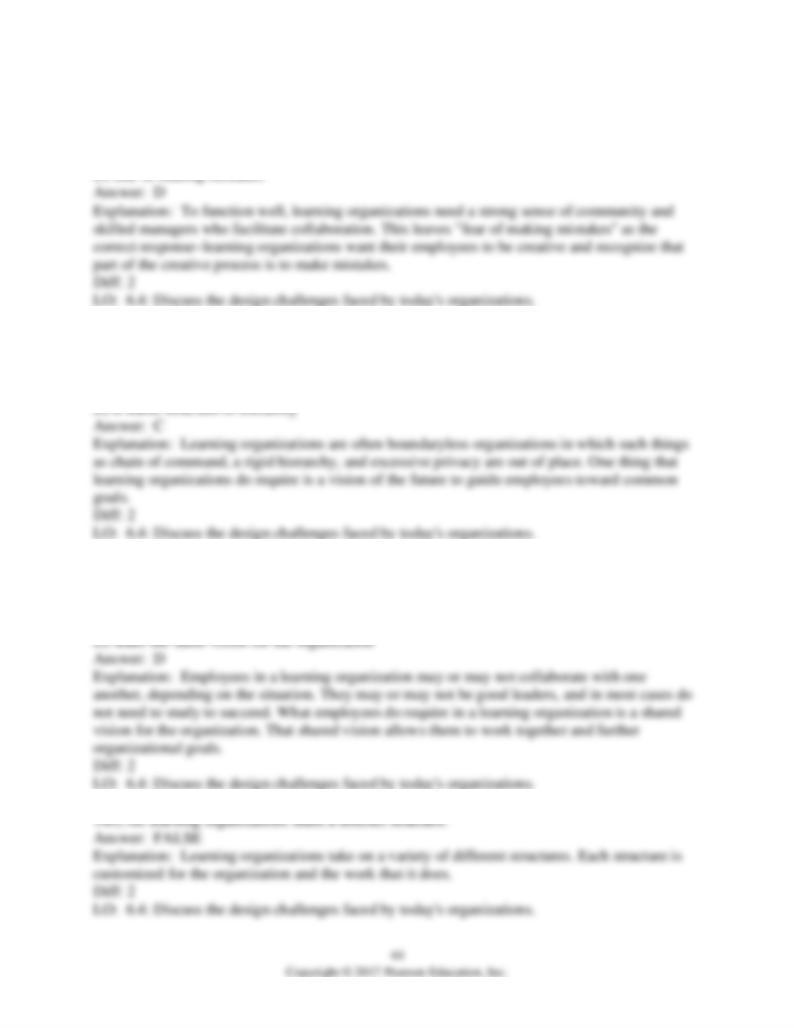
137) All of the following are characteristic of learning organizations EXCEPT ________.
A) a strong sense of community
B) a collaborative environment
C) managers who serve as facilitators
138) Organizational learning can't take place without ________.
A) complete privacy for employees
B) a clear chain of command
C) a shared vision of the future
139) In a learning organization, it is important that all employees ________.
A) collaborate
B) study each night
C) have a strong sense of leadership
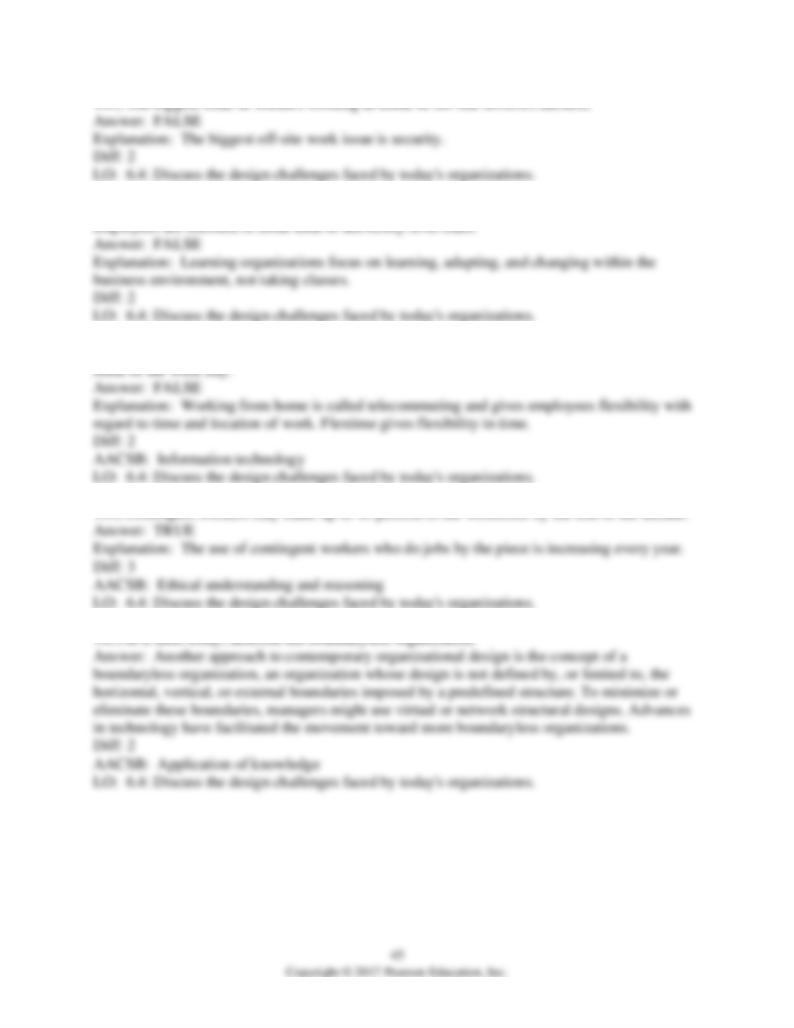
142) A learning organization puts an enormous amount of effort on making sure that all of its
143) Organizations that implement flextime programs allow employees to work at home for
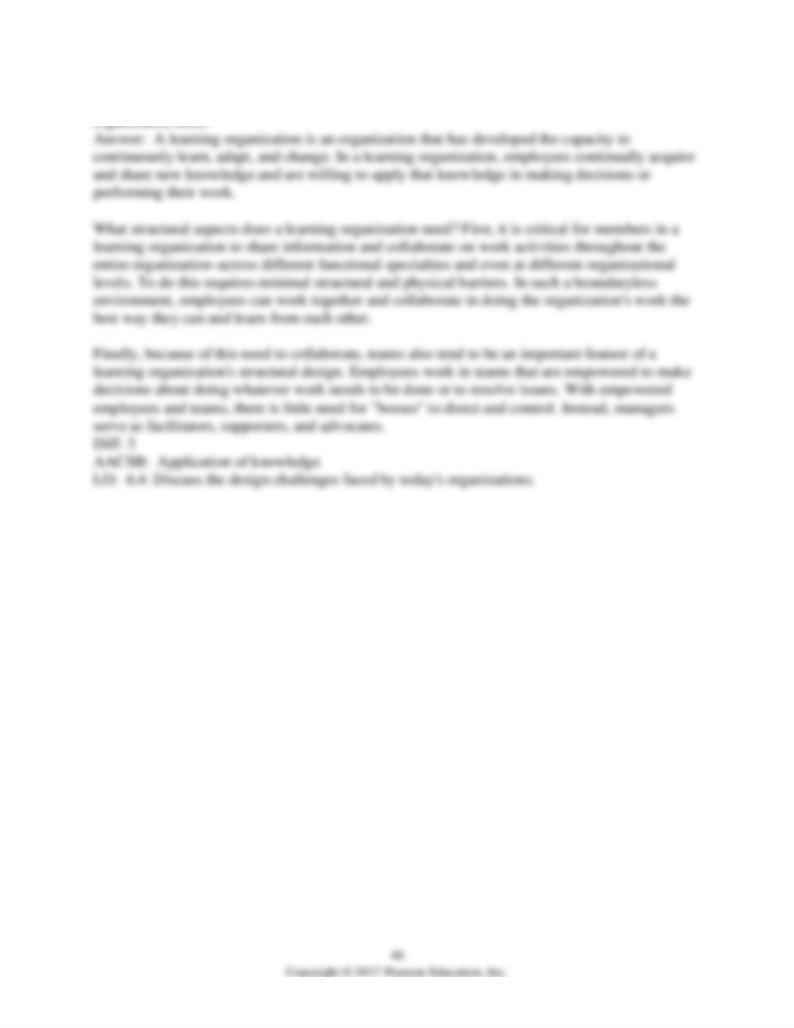
146) In a short essay, describe a learning organization. What structural aspects does a learning